
Top 3 Best Solar Panels For Sailboats

Choosing whether or not to install solar panels on your sailboat is a big decision. They are not exactly cheap, though they can start to pay themselves off pretty quickly.
This article is going to cover not only why you might want to use solar panels but all the benefits they provide. You will also find a helpful guide on which solar panels would be best for you and your budget. Hopefully, by the end, you will feel confident in your decision to install solar panels on your sailboat and even have an idea of which ones you might like.
Table of contents

Are solar panels on sailboats necessary?
Whether or not you should be installing solar panels on your boat is a matter of choice, not out of necessity. Sailboats get their power from the wind, by harnassing it in their sail. So if you plan to be sailing for the afternoon you probably don’t need solar panels.
You could charge a battery pack from the marina and that will probably see you through several trips. The problems only really start to arise if you are planning to be on your sailboat for longer periods, or even permanently. If you plan to live on your sailboat year-round, even if you spend 80% of it in a marina, you would be better off with some solar panels. Even if it is just as a backup source of power.
Are solar panels on boats safe?
Solar panels are generally pretty safe. They have no moving parts and typically have a very strong protective cover over them so you never come in contact with the electrics themself. So, as a source of power, they are generally pretty safe. The only time they may become unsafe is if they are badly damaged.
Solar panels are often covered by glass plating that keeps them safe. It also helps them absorb sunlight and warmth. This is great, except when the glass breaks. If the glass protective cover on your solar panels should crack and splinter you are at risk of serious injury from sharp shards of glass. Not only is the glass itself dangerous at this point, so are the electronic components inside. They have powerful currents running through them, and if you come in contact with them you may be in for a shock.
Furthermore, if these electronics get wet they can become deadly. Electricity and water do not mix well at all. Being as you are on a sailboat, at sea, the chances of them getting wet is very high. Luckily, the chances of them breaking in the first place are slim to none. The only real way they would break, besides vandalism, is by debris hitting them during a bad storm. There is not often debris at sea, so this shouldn’t be too much of a problem.
What are the benefits of having solar panels on a sailboat?
There are so many great benefits of having solar panels on a sailboat. They can be a lifesaver if you find yourself at sea for a long time. There benefits range from trivial comforts to being the difference between life and death. Here are some of the benefits you might not have considered about having solar panels installed on your sailboat.
Money-saving
Solar panels are not cheap, it is far cheaper to just run a generator or charge your batteries from the marina the whole time. At least, it is in the short term. Over time, it can start to become very expensive. With solar panels, you are looking at a big initial cost (the solar panels themself) and then it’s smooth sailing. You don’t need to pay for power again. Solar panels last for about 40 years before they start to become too inefficient at producing power. The cost of a few solar panels upfront compared to 40 years of marina fees and gasoline for a generator is the financially savvy move.
Emergency power
If you find yourself at sea, the wind dies down (or becomes too strong), and you find yourself stuck bobbing around waiting for more favorable conditions you may run into trouble. Depending on how long you are out there, you may find yourself with dead electronics. Be it a satellite phone, radio, or secondary engine (depending on the boat). Having a set of solar panels and a power bank can be a genuine lifesaver in these situations.
Comfort amenities
Whether you are day sailing or making a week-long voyage, having access to the comforts in life can make the whole journey so much more enjoyable. The amenities may not be available to you without having a constant source of power at sea. Having access to a kettle, tv, videogame system, radio or microwave oven may be the only thing keeping you going at rougher times. As exciting as sailing can be, when you aren’t sailing and are just bobbing around it can be quite dull. The sea is beautiful, but there is only so much time you can spend looking at the water before you miss the comforts of land. With solar panels, you can bring those comforts with you.
Eco-friendly
There are only two alternatives to solar panels. A gasoline generator, and taking power from the grid. Neither of these is good for the environment. Luckily, solar panels are a great third option. Solar panels are completely eco-friendly and are great for the environment. This is not just great for the earth, and your conscience, but for the journey itself. If you are running a gasoline generator at sea you are going to be listening to it thrumming away and smell the burning gasoline. Wouldnt you prefer silence and nothing but the smell of the sea breeze?
How much do solar panels cost?
How much solar panels cost is almost entirely tied into both their voltage/wattage and whether or not they are portable panels. Portable solar panels are great for people who don’t spend a lot of time on their boat or are happy enough living off the marina’s power grid. Permanent solar panels, the kind that may need to professionally installed, can end up costing far more. They are also likely to be far superior and you can pretty much forget about them once they are installed.
Portable solar panels will cost just a few hundred dollars each. You will need a few to be sustainable, but that’s not going to be much of a problem. These portable solar panels can just be rolled out on the deck of your boat, weighed down, and then hooked up to a battery pack. The battery itself here is going to be the most expensive part of the whole set up. A decent-sized battery could set you back a $1000. But, when charged fully it will last days. Even with constant use.
Permanently installed solar panels can cost one or two thousand dollars in some cases. The advantage here though is once they are installed that’s it, you can forget about them. You don’t have to put them up, take them down, and find somewhere to stow them every time they need using. They too will need to be hooked up to a battery, the battery is still only going to cost you $1000. If you are installing permanent solar panels because you plan to be making long voyages, it is ideal to have two or perhaps even three large batteries hooked up to your boat. One to run off, one or two for emergencies.
How do I maintain my solar panels?
Solar panels, unlike gasoline generators, are generally pretty easy to maintain. They have no moving parts and are thus pretty self-sufficient. They don’t need taking apart and they last as long as 40 years. That being said, if they do break they need repairing as soon as possible. The exposed electrics can be deadly when water is thrown into the mix. Which, on a boat, is almost always. The glass cover will need replacing and the electronics inside may need repairing, though not always. Don’t ever attempt to do this yourself unless you are experienced at making these repairs. The cost of hiring someone to do it for you is preferable to being dead. Solar panels have very powerful electric currents, that when in contact with water and yourself can be fatal. As mentioned above, these panels rarely break so you will likely not ever run into this problem. If you do, hire a contractor.
Do my solar panels need cleaning?
Solar panels work by converting the light and heat of the sun into useable power. The process itself is rather complicated but the results are simple to understand. That being said, there are some reasons that your solar panels will stop working as effectively. They all revolve around a lack of sunlight. It could be because it is night time. It could be because it is very cloudy. Or, it could be because they are dirty. If solar panels become too dusty, dirty, and become too covered in grime they stop operating at maximum efficiency. This is not as much of a problem at sea, the sea spray stops dust settling. The biggest thing you will need to clean off your solar panels is salt build-up and slime. This is easy enough to do with some warm soapy water. Freshwater, not seawater. You want to be removing as much salt as possible. Salt is corrosive to electronics, so removing it is important. Never clean your solar panels using pressure washers as they can crack the glass.
Which are the best solar panels for sailing?
There are so many options on the market at various price points. Here are three very different options that will all make good choices, depending on your needs. It is important to consider not just price but power output. Spending a lot of money on solar panels now might not feel ideal, but it is the most cost-effective decision.
1. Renogy Starter Kit
This starter kit is going to be perfect for installing on almost any sized boat. There are four solar panels, each can be fitted permanently to the boat. They can be mounted (and unmounted) easily, for your convenience. They do require a flat surface, but they are small enough that that likely won’t be too much of a problem. This starter kit is very middle of the pack price-wise but should provide enough power for a small to medium-sized vessel easily. It is also possible to buy extra panels individually should you need them.
Wattage: 400/4 (100 per panel)
2. Nature Power Rigid
The nature power rigid is a large, powerful, single solar panel. If you are looking for the right panels to power your entire boat comfortably, these are the ones for you. They are very large so they will need a large flat surface area. alternatively, they can be hung vertically from rails. This is an inefficient way of using them, so you would need to buy more this way. Nature power makes various solar panels so you could find some smaller ones of the same brand to supplement it. This one is not so easy to install, you might need to hire someone to install it for you.
Wattage: 165
3. Nature Power Monocrystalline
Nature power makes a portable solar panel that fits inside a special briefcase. It is perfect for stowing away easily and only taking it out when it is needed. It is decently powerful considering its portable, but there is the inconvenience factor of having to set it up each time. If you planned to buy the nature power rigid, buying one of these portable panels might be ideal for supplementing your power supply when it is especially sunny. Though, it may be cheaper for you to just fit more of the Nature Power Rigids.
Wattage: 120
Hopefully, you now have a good idea about whether solar panels would be right for you and your sailboat. Sailing is great, but the lack of power at sea can be dreadfully boring. Luckily, there are so many great options available on the market. Not just the ones mentioned above. Buying a solar panel is an investment, the initial cost is minor compared to the steady return from all the savings you will make.
Related Articles
Daniel Wade
I've personally had thousands of questions about sailing and sailboats over the years. As I learn and experience sailing, and the community, I share the answers that work and make sense to me, here on Life of Sailing.
by this author
Sailboat Upgrades
Most Recent

What Does "Sailing By The Lee" Mean?
October 3, 2023

The Best Sailing Schools And Programs: Reviews & Ratings
September 26, 2023
Important Legal Info
Lifeofsailing.com is a participant in the Amazon Services LLC Associates Program, an affiliate advertising program designed to provide a means for sites to earn advertising fees by advertising and linking to Amazon. This site also participates in other affiliate programs and is compensated for referring traffic and business to these companies.
Similar Posts

How To Choose The Right Sailing Instructor
August 16, 2023

Cost To Sail Around The World
May 16, 2023

Small Sailboat Sizes: A Complete Guide
October 30, 2022
Popular Posts

Best Liveaboard Catamaran Sailboats
December 28, 2023

Can a Novice Sail Around the World?
Elizabeth O'Malley
June 15, 2022

4 Best Electric Outboard Motors

How Long Did It Take The Vikings To Sail To England?

10 Best Sailboat Brands (And Why)
December 20, 2023

7 Best Places To Liveaboard A Sailboat
Get the best sailing content.
Top Rated Posts
© 2024 Life of Sailing Email: [email protected] Address: 11816 Inwood Rd #3024 Dallas, TX 75244 Disclaimer Privacy Policy

photo© www.svdelos.com
Let us help you go solar aboard, start enjoying c lean, quiet & renewable po wer.
At Sun Powered Yachts we hope to inspire and inform yacht owners on the benefits of going solar with SunPower & Maxeon. We're here to answer any questions you may have.
With a background in sailing & solar, and also from living off-grid for 11 years in Hawaii, we have the knowledge to help you with your solar install. Find out more about us
In 2021-2022 we spent 15 months as a family living aboard our sailboat, a Dufour 382 sailing from Corsica to Cancun and more recently to Florida & Bahamas. An intrepid adventure of over 7,000NM visiting 12 countries along the way. We're available for solar consultations with SunPower & Maxeon panels in stock in the USA ready to fulfill orders.
Aloha, Katie & Lyall
+1 808 825 2670
info@sunpower edyachts.com

Join over 5,700 people receiving our quarterly email updates
Thanks! You will receive our next email update . Follow us on Facebook & Instagram for latest news

SunPower ® 100 Watt
Maxeon ® a ir 3 30 watt.

SunPower ® 50 Watt

Maxeon ® 415 Watt -R (all black)

Maxeon ® 475 Watt

Maxeon ® 470 Watt
Choose your maxeon ® solar panel bundle, fixed frame panel bundles.

1x 415 Watt bundle

1x 470 Watt bundle

1x 475 Watt bundle

2x 415 Watt bundle

2x 470 Watt bundle

2x 475 Watt bundle
Visit our shop for flexible & fixed frame bundles*, *at sun powered yachts we only sell premium cosmetic quality sunpower® e-flex panels. our inventory is warehoused in arizona, please visit our shipping policy for full details , 1% for the ocean, we are committed that 1% of your order with us goes directly to support the papahānaumokuākea marine debris proj ect ( pmdp ) in hawaii. the 2024 clean up season began in april with a 19-day mission to midway atoll removin g an incredible 70,080 lbs of marin e debris .

Federal Tax Credits

Have you heard about the Federal Tax Credits that you could take advantage of for going solar on your boat? Yes, your boat!
Do you have a head, galley & bunk aboard? Then you may qualify and t he Federal Tax Credit has now gone back up to 30% of the total cost to put your solar system in place.
This can include solar panels, controllers, wiring, labor etc. and can now more easily include batteries - maybe time for that lithium upgrade to Battle Born
SunPower Advantage s

Silent power
Solar panel systems burn zero fuel and have no moving parts. They are clean and silent, producing no atmospheric emissions or greenhouse gases that are harmful to the earth. Enjoy those quiet anchorages with no more noisy engine/generator running just to charge your batteries.

Easy install
The simple and easy installation of SunPower® E-Flex panels on your bimini, dodger, or deck, will reduce costs of adding an expensive davit or custom racking and mounting solution for traditional large & heavy fixed frame solar panels.

Highest quality
Incredibly reliable and easy to maintain. With no moving parts, visual checks and servicing easily keep systems operating. Solar panels are robust & durable with a junction box designed with a high level of protection from dust & water ingress.
SunPower Solar Panel Installs

Follow us on Instagram @sunpoweredyachts
News & reviews.

Maxeon to open new factory in USA
Great news! Maxeon recently announced (Aug 10th) that they will be opening a 3 Gigawatt factory in New Mexico. Construction will begin Spring 2024 and so by 2025 that's high efficiency Maxeon solar panels being made right here in the USA!
Read our news post for full details.

For sale - 'Blake' our Dufour 382
Are you looking for a boat already set up to go cruising? We have our 2016 Dufour 382 GL 'Blake' listed for sale on Yacht World . She is the adventure version with taller mast/deeper keel, 950W of SunPower flexible solar panels, a DC watermaker, new dinghy and plenty of safety gear. Currently in Freeport, Bahamas. For more details contact us directly
T: 808 825 2670

Check out our Install List
We have added an Install List page to our website which currently has over 130 installs from our customers. Get inspired by what other boat owners have added for SunPower & Maxeon solar panels.
Maybe you own a Lagoon 400 or a Morgan 41 and wonder what panels might fit aboard, check out the list to see how other owners have gone solar aboard.

Calico Skies 3x 410W
Bill & Grace sail Calico Skies , a Sabre 36, and whilst in Mexico they installed 3x410W SunPower fixed frame solar panels as part of a major upgrade to their arch/davit system.
Check out their YouTube episodes including #177 to see how they get on adding 1,230W (or 1.23kW) of SunPower solar panels.
Calico skies install details
"We made 7.2kWh yesterday out of our panels, what an upgrade!"
Bill & Grace

SV Delos 3x 410W + flex
Brian & Karin of SV Delos installed 3x410W SunPower fixed frame panels when on the hard in Mexico ( YouTube Ep.407 )
Combined with their SunPower E-flex panels, which have been aboard for ~3 years ( YouTube Ep.262 ) they now have just under 2,00W of solar keeping them powered up in the Pacific - awesome!
SV Delos install details
"Love our new 410W panels and they're the same size as the old 300W ones - woohoo!"
Brian & Karin

Sailing La Vagabonde 2x 470W + flex
Riley & Elayna of Sailing La Vagabonde have been working on their new Rapido 60' trimaran and added 2x470W Maxeon fixed frame panels.
They also have 6x170W SunPower flex panels they can deploy when needed. With a 48V battery bank these panels are wired in series YouTube episode
SLV install details
"Thank you, the solar panels have been absolutely incredible."
Riley & Elayna
Testimonials

"So now I generally
Don't bother hooking, up to shore power".
Thanks for all the help in planning my solar project for my boat. The two 170W flexible panels fit well on my Bimini and now I generally don't bother hooking up to shore power. Although I haven’t had any long trips since my installation I have done a few day trips. And even with fridge, radio, plotters, autopilot and occasional radar it seems that these panels are keeping up with my usage. The advice and service has been great. Thanks again.
Jeanneau Sun Odyssey 469

"It is by far the best decision I made "
I bought a solar system from Sun Powered Yachts in 2020. It is by far the best decision I have made for the electrical system on my boat. I would (and do) recommend Sun Powered Yachts to anyone looking to add solar to their boat.
Endeavour 33

"Terrific customer service, always responsive"
The process of researching a solar solution for my Beneteau 41 was simplified & clearly understood once I discovered Sun Powered Yachts. Terrific customer service, patient, always responsive with guidance and products that just work. Being a novice at setting up a solar system, I had many questions along the way, and the team at Sun Powered Yachts were always there to answers my questions and provide support.
Beneteau 41
Become a more sustainable sailor with SunPower® & Maxeon® solar panels
Sunpower® solar videos, jodi endicott environmental art june 2024.

Our Beautiful Boat Home (FULL BOAT TOUR)

Mastering OFF-GRID Living: 4 Key Things Every Sailor Should Know ⛵️ Sailing Vessel Delos Ep. 441

New Feature: Prioritising solar or wind when on shore power Victron Energy
GOING SOLAR - Video by Profiles in Dust (2023)

Custom Double Flexible Solar Panel Mounting System (No Drilling, Welding, or Permanent Adhesive)
Save 40% off! Join our newsletter and get 40% off right away!
Sailboat Life
Sailboat Cruising and Lifestyle Magazine.

Sailboat Solar Systems and How-To

Solar on a sailboat goes together like hands and gloves, but sailboat solar systems can be installed in a variety of ways. The solar components themselves create an infinite combination of possibilities for off-grid sailing. Victron Energy chargers, Renogy Panels, Sunpower Yachts, BlueSea Systems, and many more brands have entered the marketplace, and that’s not including the lithium battery companies.
To simplify things, we’ve compiled three sailboat solar systems videos to give you an overview of what’s possible. And to help you decide on your own simple solar panel setup for sailing.
How-To Install Solar Panels on Your Sailboat
This system from Zingaro shows flexible panels summing 300w of power on a 38′ catamaran.
300W Solar System:
- Three 100w solar flexible panels
- 1 MPPT Solar charger controller
View on Amazon >>
100W HQST Flexible Solar Panels $100-$200
20amp Solar Charge Controller by Victron Energy $150-$200

Simple Sunpower Solar System
This simple solar system from The Fosters shows a quick and easy setup with limited space on top of a bimini.
Sunpower Solar Panels are considered by most in the industry as the gold standard. They use the highest-efficiency solar cells and have top-notch build quality. In this simple installation, three 50w panels are just enough to get you started. Plus, it’s the most affordable installation!
150w Starter Solar System
- Three 50w Flexible Solar Panels
- A Single 15amp solar charge controller
50W Sunpower Solar Panels $150-$200
75v/15amp Solar Charge Controller by Victron Energy $100-$124

Off-Grid on a DIY Solar Powered Sailboat
Here’s a special installation that turned a derelict sailboat into an off-grid sailing machine!
Simon has transformed this derelict sailboat into an epic off-grid solar-powered and fossil-fuel-free cruising catamaran. He’s been living aboard and renovating the boat for the past 3.5 years We’re excited to show you the transformation as well as how he plans to propel the boat without the use of diesel or fossil fuels!
5280w Solar System for Electric Powered Catamaran
- 16 Rigid solar panels (330w each)
- 20kwh of Lithium Batteries
240W Rigid Solar Panels $250-$300
200AH Lithium 4d Battery $1200-$1200

Share this post!
Throw in your two cents, start a discussion cancel reply, related articles.

The Voyage of the Sea Star – 35ft Sloop to Bermuda

Living Aboard a 30-36ft Sailboat: A Guide for the Curious and Adventurous

Summer Sailboat Video, Bikinis, Sails, and Fun

Saved Up For This Dream
ACTIVE STORM TRACKER Hurricane and Tropical Storm Information Learn more

Service Locator
- Angler Endorsement
- Boat Towing Coverage
- Mechanical Breakdown
- Insurance Requirements in Mexico
- Agreed Hull Value
- Actual Cash Value
- Liability Only
- Insurance Payment Options
- Claims Information
- Towing Service Agreement
- Membership Plans
- Boat Show Tickets
- BoatUS Boats For Sale
- Membership Payment Options
- Consumer Affairs
- Boat Documentation Requirements
- Installation Instructions
- Shipping & Handling Information
- Contact Boat Lettering
- End User Agreement
- Frequently Asked Questions
- Vessel Documentation
- BoatUS Foundation
- Government Affairs
- Powercruisers
- Buying & Selling Advice
- Maintenance
- Tow Vehicles
- Make & Create
- Makeovers & Refitting
- Accessories
- Electronics
- Skills, Tips, Tools
- Spring Preparation
- Winterization
- Boaters’ Rights
- Environment & Clean Water
- Boat Safety
- Navigational Hazards
- Personal Safety
- Batteries & Onboard Power
- Motors, Engines, Propulsion
- Books & Movies
- Cockpit Confessions
- Communication & Etiquette
- Contests & Sweepstakes
- Colleges & Tech Schools
- Food, Drink, Entertainment
- New To Boating
- Travel & Destinations
- Watersports
- Anchors & Anchoring
- Boat Handling
What You Need To Know About Boat Solar Panels
Advertisement
Sunshine and boats are a natural together, so why not use all that free energy? Here’s the lowdown on solar panel selection and installation
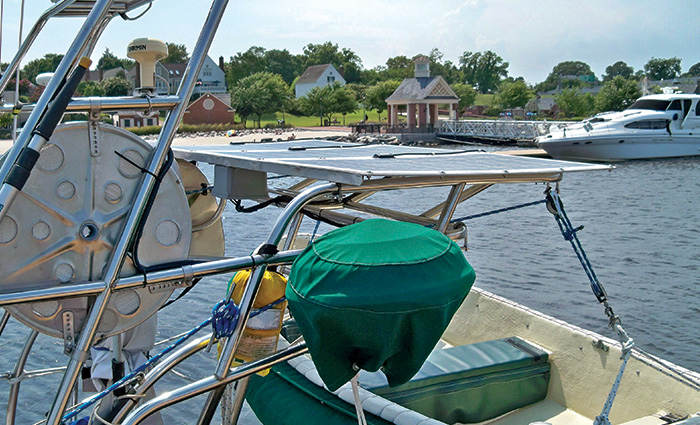
I first embraced the idea of solar power while up a pole (literally) in the Atlantic Intracoastal Waterway replacing dead batteries. It was the early 1980s, and I was maintaining buoys, beacons, and other such Aids To Navigation (ATON) for the U.S. Coast Guard, replacing massive, nonrechargeable batteries with rechargeable solar-powered ones. The higher-ups said the solar rechargeables would last six years – twice as long as the one-shot batteries. As the deck-ape in charge of lugging all those batteries up and down the ladders, my back and I immediately appreciated the whole “free power from the sun” thing, a concept I continue to embrace.
The strategy behind s olar energy onboard is simple: A solar panel converts sunlight into electricity, after which wiring conducts it to your batteries for storage until needed. Solar panels are used to keep batteries or banks charged rather than to power equipment directly. This arrangement allows the panels to store generated power whenever produced, while providing a steady source of power to a piece of equipment even when the panel is producing no power.
While they do require an initial outlay, solar panels can easily pay for themselves in money saved and independence gained over their service life. They’re noiseless, have no moving parts, and they provide free electricity for years with minimal maintenance. Solar panels also have the benefit of being modular, letting you start small and add more as your power requirements increase.
The benefits of solar
Almost any boat can benefit from solar power. Whether at a slip, mooring, or on a trailer, boats can keep their batteries topped off without the need for external power. You can also use solar power to supplement or even replace other onboard charging sources, reducing or eliminating the need to run engines or generators to keep batteries topped off (a wasteful practice that burns fuel while wearing down the costliest pieces of equipment onboard).
While underway, it’s a plus to be able to recharge a dead battery in an emergency – say, to operate a VHF radio or navigation gear. While dockside, solar panels keep batteries charged and vital systems (such as bilge pumps) up and running without the need for shore power.
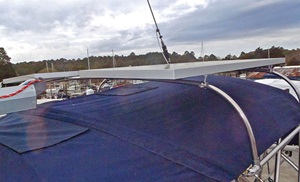
Just about any boat can benefit from solar power, whether it’s to keep batteries topped off or supplement other onboard charging sources.
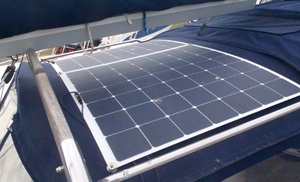
Mount solar panels where they are exposed to maximum sunlight but do not interfere with operation of the vessel.
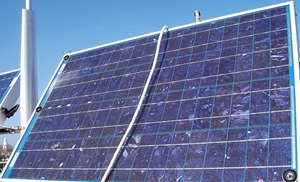
Bottom: Something as simple as the shadow of a line or shroud can reduce or halt output.
Types of panels
Solar panels contain photovoltaic cells – small silicon semiconductor devices that convert sunlight into electricity. Each cell generates between 0.45 and 0.5 volts, depending on exposure to direct sunlight. Cell size determines amperage, with a 3-inch cell producing roughly 2 amps, a 4-inch cell a little over 3 amps, and a 5-inch cell around 5 amps.
Construction-wise, the three main types of solar panels are monocrystalline, polycrystalline, and amorphous (or thin-film) technology.
Monocrystalline panels have been around the longest and remain the most popular. The panels are constructed of thin slices of crystal silicon (each cell is cut from a single crystal) housed in a rigid, aluminum frame and covered with tempered shatterproof glass. The panels have a uniform black, blue, or gray appearance and are generally quite rugged, although they can be cracked or broken if subjected to extreme abuse.
Monocrystalline panels have the longest service life of the three types. With a conversion efficiency of around 17%, they’re also the most efficient and have the highest electrical output per area, but they are also the most expensive.
Polycrystalline cells are sliced from a cast silicon block and have a shattered glass appearance. Built in much the same way as monocrystalline panels, they’re rectangular, giving the panel itself a tiled look. Their life span is similar to monocrystalline panels, and while their conversion efficiency is lower (by 14%), they’re also a bit less expensive.
Amorphous panels are made by placing a thin film of active silicon on a solid or flexible backing (such as stainless or aluminum sheeting) depending on whether the panel is to be rigid-framed and glass-fronted or flexible. Flexible amorphous panels, in which cells are sandwiched between rubber and polymer covers, are light and tough enough that you can walk on them and, in some cases, even roll them up for storage.
This type of solar panel is also better if shade is an issue. With crystalline panels, even the thin shadow of a rope or shroud across one cell can reduce or halt output of an entire module. Amorphous panels have “bypass” diodes that essentially turn off shaded cells and provide a current path around them. Some monocrystalline panels also have bypass diodes, but this feature comes at an increase in cost.
Amorphous panels are the least expensive of the three types, but their efficiency is also lower – around 8%, or roughly half that of a monocrystalline type. This lower output is somewhat mitigated in newer panels, however, which use three-layer construction. Each layer absorbs different colors of the solar spectrum, so the panel will deliver more power longer each day and during lower light conditions than the other two types.
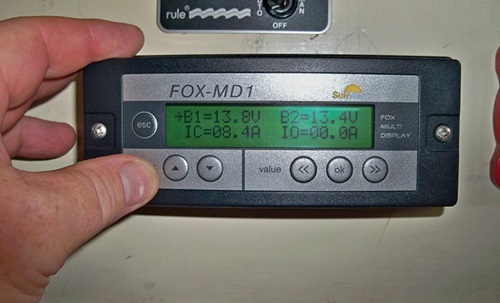
The charge controller should be mounted below decks and as close to the battery as possible.
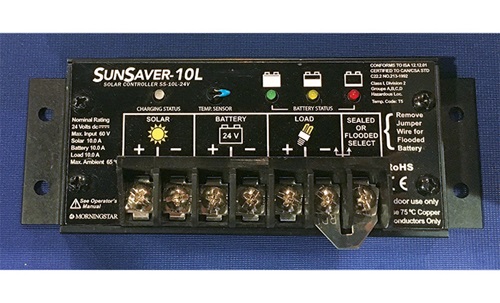
Follow manufacturer instructions for wire connections.
Planning the system
While factors such as cost, mounting options, and output are important, a successful installation depends on knowing what you want the system to accomplish. Is the goal to float-charge a single battery or supplement an overall vessel energy plan? Answering these questions up front will help determine the type, size, and number of panels required.
To understand the process better, let’s walk through the basic steps to determine power requirements and installation considerations for a single solar panel installation. While the example itself is simple, the steps are the same used to plan more complicated installations.
For our example, the goal is to install a solar panel to provide charging for a single 12-volt, 100-amp-hour wet-cell battery used to power an automatic anchor light on a moored vessel.
The first step is compiling a daily power consumption estimate to determine how much solar power is needed.
The daily self-discharge rate for a wet-cell battery is roughly 1%, meaning our 100-amp-hour battery requires one amp every 24 hours just to maintain the status quo. The anchor light draws 50 milliamps per hour of operation, and we’ll assume it operates 10 hours each night. Multiplying current draw (50 milliamps) by hours of daily operation (10) generates a daily energy expense of 500 milliamps or .5 amps.
This means our solar panel must meet a minimum daily energy tab of 1.5 amps – one amp of battery self-discharge rate plus .5 amps of power draw for the anchor light.
Next up is figuring out panel size and the best mounting location. For our example, let’s assume the panel will be a horizontal, fixed-mount installation. A 10-watt horizontally mounted panel should generate between 3- and 5-amp hours per day.
We’ll need at least 13 volts to fully charge our 12-volt battery. As most solar cells generate at least 0.45 volts, you’ll want a panel with a minimum of 33 cells, which should provide around 14.85 volts.
Keep in mind that’s the minimum needed, which may not be enough once you factor in a few cloudy days. Most panels are designed to generate between 15 and 20 volts to overcome problems like cloudy days or inherent electrical resistance within the panel or installation components. While this higher voltage lets you make up for less electrically productive days, it also means you’ll want to install a solar charge controller (voltage regulator) to avoid battery damage due to overcharging.
Attempts to plan a system that tries to use the output of the panel and capacity of the battery to prevent overcharging (and avoid the installation of a charge controller) is false economy and should not be done. The system will never meet its full output potential and, worst case, can damage the battery due to overcharging.
A word on ‘charge controller confliction’
If your vessel has multiple charging sources, such as solar panels and a wind turbine, a crucial but often overlooked consideration is “charge controller confliction.” In short, this is an issue where the charge controller for your solar panel and the charge controller for your wind turbine are internally adjusted to the same maximum charge voltage set point. This means they are constantly fighting each other to be the dominant power source, which results in diminished overall charging output and performance. An in-depth article on this issue can be found at missioncriticalenergy.com (in the website footer, click “Superwind Turbine Manuals & Technical Bulletins.” Under the header “Charge Controllers,” select the document “Resolving Charge Controller Confliction”).
While this article addresses charge controller confliction at remote, off-grid sites, the information provided is also applicable to vessel installations. — F.L.
Location and mounting
Solar panels should be mounted in a location where they are exposed to the maximum amount of sunlight but do not interfere with operation of the vessel or the movement of passengers and crew. Solar panels will typically be either fixed or mounted on some type of movable bracket that allows you to actively point the panel toward the sun for maximum output. Both methods have their pros and cons. Fixed panels (which are normally mounted horizontally) don’t produce as much power as a panel that can be adjusted to face the sun. The downside is that adjustable panels must be aimed throughout the day to maximize their output.
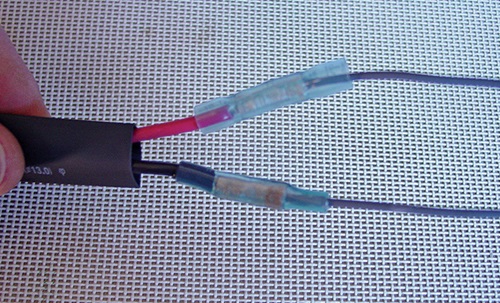
Use good quality, marine-grade heat shrink connectors (top) and liquid electrical tape (right) to create airtight, waterproof seals and reduce corrosion.
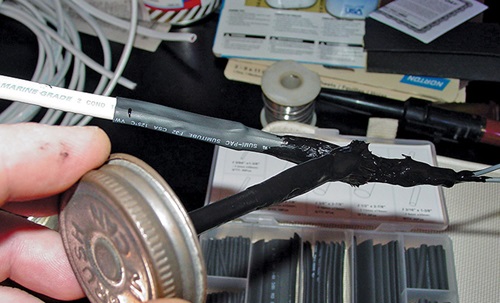
Installation
After choosing and mounting your panel, it’s time to connect it. The first thing you need to determine is the size (gauge) of the wiring to be used. Multiply your panel’s rated amp output by 1.25 (which adds a 25% safety factor). Then measure the length of the entire wiring run, panel to battery, and multiply by 2. Once you have these two numbers, refer to the American Boat and Yacht Council’s (ABYC) 3% voltage-drop table for wire size. Ancor Products offers a handy wire calculator on its website ( ancorproducts.com/resources ).
Always use good quality marine grade connectors and tinned, multi-stranded copper wire with vinyl sheathing. The wire will run from the solar panel to the charge controller first, then to the battery. Try to keep the wire run as short as possible, and if it transits an external deck or cabin house (it likely will), be sure to use an appropriate weatherproof deck fitting.
The charge controller should be mounted below decks and as close to the battery as possible. You’ll always want to follow the manufacturer’s instructions for connections, but in a typical installation you’ll connect the solar panel’s positive (red wire) lead to the charge controller’s positive input wire or terminal and the negative (black wire) lead to the charge controller’s negative input wire or terminal.
Next, connect the charge controller’s negative output to the battery negative terminal and the controller’s positive output to the battery’s positive terminal via an appropriately sized in-line fuse (or circuit breaker). ABYC recommends these be installed within 7 inches of connection to the battery or other point in the DC system. To reiterate, the installation of the charge controller can vary among models, so follow the manufacturer’s installation instructions.
Finally, ensure all connections are waterproof and secure any loose wire runs with wire ties and cable clamps for a neat installation. Then get ready to lean back and soak up some free sun.
Related Articles
The truth about ceramic coatings for boats.
Our editor investigates the marketing claims of consumer-grade ceramic coatings.
Fine-Tune Your Side Scan Fishfinder
Take your side-scanning fishfinder off auto mode, and you’ll be spotting your prey from afar in no time
DIY Boat Foam Decking
Closed-cell foam flooring helps make boating more comfortable. Here’s how to install it on your vessel
Click to explore related articles
Frank Lanier
Contributing Editor, BoatUS Magazine
Capt. Frank Lanier is a SAMS-accredited marine surveyor with over 40 years of experience in the marine and diving industries. He’s an author, public speaker, and multiple award-winning journalist whose articles on boat maintenance, repair, and seamanship appear regularly in numerous marine publications worldwide. Contact him via his YouTube channel “Everything Boats with Capt. Frank Lanier” or at captfklanier.com.
BoatUS Magazine Is A Benefit Of BoatUS Membership
Membership Benefits Include:
Subscription to the print version of BoatUS Magazine
4% back on purchases from West Marine stores or online at WestMarine.com
Discounts on fuel, transient slips, repairs and more at over 1,200 businesses
Deals on cruises, charters, car rentals, hotel stays and more…
All for only $25/year!
We use cookies to enhance your visit to our website and to improve your experience. By continuing to use our website, you’re agreeing to our cookie policy.
Yachting Monthly
- Digital edition

Best Solar panels for off-grid power and keeping batteries charged
- Phil Sampson
- November 28, 2022
We take a look at 6 of the best solar panels for boats, from folding units to cutting-edge flexible panels

Free power forever? If only it was that simple! Photo: Graham Snook
For many in the boating community, solar panels represent something of a holy grail. They are, after all, the gift that keeps on giving, aren’t they? Free power forever, (or many years anyway), coupled with zero running costs – what could possibly be better than that?
All you have to do to make this dream come true is banish the memory of the purchase price from your mind – something boaters are notoriously adept at doing – and wait for the sun to shine. If only it were that simple…
The fact of the matter is that there are costs associated with solar panels beyond the price of the panels themselves. While some types of panels can be simply laid on the deck, in many cases some form of mount will be required.
Then there’s the wiring to hook them up to your battery, plus any fitment and/or cosmetic work needed to hide the cabling from view. If your panels are to be left connected permanently, you’ll require a regulator too.
This will prevent both overcharging and a reverse flow of power out of the battery after dark. If you do not fit a regulator, a blocking diode can be used to halt the reverse flow instead.
But once all of the above have been overcome – and providing you’ve done your homework to ensure your panels will generate sufficient power to cover your needs – then, yes, it’s a power free for all!
There are many other benefits to boat solar panels too: First and foremost, they work all on their own – solar panels are automatic, so you can just let them get on with the job.
Apart from the occasional wipe over and a wiring check, they’re largely maintenance-free too. Unlike wind generators, (especially like the one with wonky bearings on that boat moored next to you), they don’t make any noise.
And finally, your batteries will be pleased, because keeping them from going flat can extend their life.
Here’s our choice of the best boat solar panels.
6 of the best boat solar panels available right now

Giosolar 1,000W flexible solar panel
Best flexible boat solar panel
Delivering a mighty kilowatt of power, (not far off the amount used by a one bedroom house), this Giostar package comprises ten separate 100W panels, each of which is 1,050 x 540 x 2.5mm in size.
Capable of charging either 12 or 24V batteries, a kit of this magnitude is one for the most serious of solar enthusiasts – Eco Experts reckons 660-990W is sufficient for a liveaboard.
Giostar panels are abrasion resistant, anti-rust and dust proof and their junction boxes are sealed and waterproof. The panels are also light, thin and flexible, and can withstand being bent up to 30 degrees.
Reasons to buy: Incredible amount of power, panels are abrasion resistant as well as anti rust + dust proof
Reasons to avoid: Premium price
Price: £1,464.45
Buy it now on Amazon (UK)
Note: We may earn a commission when you buy through links on our site, at no extra cost to you. This doesn’t affect our editorial independence.
Ecoflow 160w portable solar panel.

Mobisolar 100W foldable solar panel
Best foldable boat solar panel
Mobisolar’s foldable panels are light (4.5kg) and measure 121 x 56.5 x 3 cm when unfolded, with the longest dimension reducing to 60 cm when folded, making them easy to transport.
The panels use advanced technology to provide superior performance, with each panel subjected to a thorough testing routine before and after assembly.
So confident is Mobisolar in its products that the company stands behind its panels with a two-year defect warranty and a five years’ electrical performance warranty.
For maximum flexibility in operation, three USB power outputs are fitted per panel, one delivering 100W, the second 60W and the third 10W.
Reasons to buy: Foldable, lightweight and long warranty
Reasons to avoid: Not resistant to the elements, doesn’t feature mounting holes
Price: £145.00
Buy it now on eBay

Eco-worthy 100W solar panel kit
With 100W panels being ideal for keeping batteries topped up, our second offering in this power class is from Eco-worthy, a major player in the solar panel field.
Competitively priced, our link below is for a kit which includes an LCD control unit and four ‘Z’ brackets in addition to the panel itself.
The Eco-worthy 100W panel is of the monocrystalline type, which means their cells are made from an ingot grown from a single silicon crystal of high purity. It’s also a rigid panel, so this particular product would need to be mounted on a frame or flat surface.
Reasons to buy: Competitively priced, Features LCD panel, brackets
Reasons to avoid: Only a year warranty, not resistant to elements
Price: £113.99

PV Logic 20W Flexi solar panel
Offered by Force 4 Chandlery, this lightweight semi-flexible solar panel comes complete with a dual battery solar charge controller.
The panel is completely waterproof thanks to its six-layer, heavy-duty laminate finish, and should a wayward crew member plod over it in their size 9s the panel’s dimpled top surface is ‘self healing’.
The controller can handle both 12 and 24V systems and the panel’s PWM (Pulse Width Modulation) charging system is efficient and battery-lifetime friendly.
Supplied with LED battery-status indicators and 4 metres of cable, PV Logic Flexi panels can be bonded to flat or curved surfaces.
Reasons to buy: Lightweight, waterproof, dual controller
Reasons to avoid: Lacks mounting options
Price: £149.95
Buy it now on Force 4 Chandlery

Powoxi 10W solar panel
At the budget end of the market comes this Powoxi 10W solar panel charger kit. While you won’t go far on just 10W of power, this kit claims to be capable of charging and maintaining various 12V batteries.
The kit features a fully automatic charging and maintenance controller, which provides intelligent three-level charging and protection against short- and open-circuits, under voltage and overloading.
A reverse flow system is included and the interface is described as ‘plug and play’. While the panel is rainproof, it will not withstand immersion in water, so this is a product to perhaps leave behind on the dock when you take to the water.
Reasons to buy: Great budget option, plug and play
Reasons to avoid: Not waterproof, won’t go far on 10V
Price: £27.59

Eco-worthy 10W/5W solar panel
The least pricey option we could find anywhere, this baby 5W solar panel is simply a trickle charger. But if that’s all you need then look no further, for this is another Eco-worthy product.
The technology in the panel is polycrystalline, so it’s not the most efficient on the market, but for this power that’s hardly a great concern.
The panel is supplied with two charging options; a pair of crocodile clips which attach directly to the battery, and a cigarette lighter plug.
According to the product’s eBay listing, this seller alone has sold approaching 3,000 of these units – and at this price, we can understand why!
Reasons to buy: Incredible price, can be charged via car lighter plug
Reasons to avoid: Small, not very efficient
Price: £9.99
Yacht Solar: Exploring the Advantages of Flexible Solar Panels for Boats
When it comes to sailing the open waters, boat owners are constantly seeking innovative ways to enhance their boating experience while being mindful of the environment. One such breakthrough in marine technology is the utilization of flexible solar panels for boats. In this article, we will delve into the world of marine solar panels, discussing their benefits, applications, and the various options available in the market.
Sailing enthusiasts are increasingly turning to flexible solar panels as a viable solution to power their boats sustainably. These innovative panels offer significant advantages over traditional rigid solar panels, making them a popular choice among boat owners worldwide.
1. Understanding Flexible Solar Panels for Boats
1.1 what are flexible solar panels.
Flexible solar panels, also known as thin-film solar panels, are made of lightweight and flexible materials such as amorphous silicon. This flexibility allows them to conform to various curved surfaces on boats, making them an excellent choice for marine applications.
1.2 How Do Flexible Solar Panels Differ from Conventional Panels?
Unlike conventional solar panels that use rigid crystalline silicon cells, flexible solar panels use thin-film technology, which makes them more versatile. Traditional panels are bulkier and heavier, while flexible panels are lightweight and easy to install.
1.3 The Advantages of Using Flexible Solar Panels on Boats
The benefits of flexible solar panels on boats are manifold. They are lightweight, durable, and resistant to impacts, making them ideal for marine environments. Additionally, their flexibility allows them to fit on curved surfaces, maximizing the use of available space on boats.
2. Addressing Rust Concerns in Marine Solar Panels
2.1 the impact of rust on traditional solar panels.
Traditional solar panels are often mounted using metal brackets or frames. In marine environments, these metal components are susceptible to rust due to exposure to saltwater and humidity. Rust can compromise the structural integrity and efficiency of the panels.
2.2 Why Flexible Solar Panels are Rust-Resistant
Flexible solar panels do not require metal brackets for installation. As a result, they are not as vulnerable to rust as their rigid counterparts. This advantage extends the lifespan of flexible panels and ensures optimal performance even in corrosive marine conditions.
3. Empowering Boats with Solar Panels and Batteries
3.1 combining solar panels with battery systems.
Integrating solar panels with boat batteries creates an independent and sustainable energy system. Solar panels generate electricity during the day, which can be stored in batteries to power various onboard appliances and equipment, even during cloudy or nighttime conditions.
3.2 Advantages of Using Solar Panels for Boat Batteries
Using solar panels for boat batteries reduces the reliance on traditional power sources, such as generators or shore power. This not only cuts down operational costs but also reduces noise pollution and emissions, promoting eco-friendly boating practices.
4. Exploring Flex Solar Panels for Marine Applications
4.1 the versatility of flex solar panels.
Flexible solar panels can be installed on various boat surfaces, including the deck, hull, and bimini tops. Their lightweight and pliable nature allow them to adapt to the unique contours of different boat designs.
4.2 Installing Flex Solar Panels on Different Boat Surfaces
Boat owners can install flexible solar panels using adhesives or by sewing them into canvas materials. This installation flexibility offers convenience and ensures a seamless integration with the boat's aesthetics.
5. The Rise of Flexible Solar Panels in the UK
5.1 marine flexible solar panels in the uk.
The UK, with its extensive coastline and thriving boating community, has seen a surge in the adoption of flexible solar panels. Boat owners are increasingly recognizing the long-term benefits of harnessing solar power for their marine activities.
5.2 Embracing Sustainable Boating Solutions
The popularity of flexible solar panels in the UK reflects the growing awareness and commitment to sustainable boating practices. As environmental concerns mount, the marine industry is actively seeking eco-friendly solutions to minimize its carbon footprint.
6. The Convenience of Boat Solar Panel Kits in the UK
6.1 all-in-one boat solar panel kits.
Boat solar panel kits offer a convenient solution for boat owners looking to embrace solar power. These kits come with all the necessary components, including panels, mounting hardware, charge controllers, and connectors, making installation hassle-free.
6.2 Harnessing Solar Energy Effortlessly
Boat solar panel kits provide boat owners with a simple and effective way to harness solar energy. By generating electricity from the sun, boaters can extend their time on the water without worrying about depleting conventional power sources.
Read our top notch articles on topics such as sailing, sailing tips and destinations in our Magazine .
Check out our latest sailing content:
7. understanding the issue of panel rust, 7.1 common causes of panel rust.
Panel rust in traditional solar panels is primarily caused by exposure to moisture and salty air. It can lead to corrosion and decrease the efficiency of the panels over time.
7.2 Preventive Measures and Solutions
Flexible solar panels, being less prone to rust, require less maintenance. However, boat owners can further protect their panels by choosing anti-corrosive mounting options and performing regular inspections.
a8. Harnessing the Power of 12V Solar Panels for Boats
8.1 the advantages of 12v solar panels.
12V solar panels are a popular choice for boats due to their compatibility with standard marine battery systems. They are easy to install and can efficiently charge 12V batteries.
8.2 Enhancing On-Board Energy Efficiency
By installing 12V solar panels, boat owners can optimize their onboard energy consumption and reduce the reliance on engine-driven charging methods, saving both fuel and money.
9. The Best Solar Panel Kits for Boats in the UK
9.1 top picks for boat solar panel kits.
Several reputable manufacturers offer high-quality solar panel kits designed specifically for marine applications. Researching and comparing different kits can help boaters find the best fit for their needs.
9.2 Factors to Consider When Choosing Solar Panel Kits
When selecting a solar panel kit, factors such as wattage, efficiency, and durability should be taken into account to ensure a reliable and long-lasting solution.
10. Enjoying the Sun with Boat Sun Power
10.1 embracing solar energy for recreational use.
Solar power enables boaters to enjoy recreational activities without the noise and fumes associated with traditional power sources. It opens up new possibilities for leisurely and environmentally-conscious boating.
10.2 The Pleasures of Environmentally-Friendly Boating
Boat sun power offers a cleaner and greener way to explore the waters, preserving the marine ecosystem and contributing to sustainable tourism.
11. Exploring Marine Solar Panel Kits
11.1 preparing your boat with solar panel kits.
Installing marine solar panel kits requires careful planning and consideration of the boat's layout and energy needs. Consulting with experts can ensure a well-designed and effective solar power system.
11.2 Advantages of Customizable Marine Solar Panel Kits
Customizable marine solar panel kits allow boat owners to tailor the system according to their energy requirements and space limitations. This customization maximizes energy output and overall efficiency.
12. Sailing the Future: Solar Sailboats
12.1 the concept of solar sailboats.
Solar sailboats take sustainability to new heights, utilizing large solar panels to power electric propulsion systems. These futuristic vessels offer emissions-free and silent sailing.
12.2 Eco-Friendly Sailing with Solar Power
Solar sailboats pave the way for eco-friendly yachting, promoting renewable energy use and reducing the environmental impact of maritime travel.
13. Optimizing Sailboat Solar Panel Mounts
13.1 choosing the right solar panel mounts for sailboats.
Selecting the appropriate solar panel mounts is crucial for maximizing energy production. Properly positioned panels receive the maximum sunlight exposure throughout the day.
13.2 Ensuring Optimal Sunlight Exposure
By strategically installing sailboat solar panels, boat owners can capture more sunlight, ensuring a steady flow of clean energy for their sailing adventures.
14. Sailing with Solar Power: Harnessing the Sun
14.1 how solar panels enhance boat efficiency.
Solar panels offer boat owners a reliable and renewable power source, reducing the reliance on traditional fossil fuels and enhancing overall energy efficiency.
14.2 The Future of Solar-Powered Sailing
As technology advances and renewable energy becomes more accessible, the future of solar-powered sailing looks promising, with boats becoming even more eco-friendly and sustainable.
15. Finding the Best PV Panels for Boats
15.1 understanding photovoltaic panels.
Photovoltaic (PV) panels are the heart of any solar power system. Understanding their efficiency and construction is essential for selecting the best PV panels for boats.

15.2 Selecting High-Quality PV Panels for Boats
High-quality PV panels offer better performance, durability, and longevity. Investing in top-tier panels ensures a higher return on investment and a more eco-friendly boating experience.
Embracing solar technology in the form of flexible solar panels offers boat owners a clean, sustainable, and cost-effective way to power their vessels. The advantages of flexible solar panels, such as their rust-resistance, installation flexibility, and efficiency, make them an ideal choice for marine applications. As the world seeks greener alternatives, the future of boating lies in harnessing the power of the sun, enabling sailors to embark on eco-friendly adventures on their solar-powered yachts.
So what are you waiting for? Take a look at our range of charter boats and head to some of our favourite sailing destinations.
FAQs: Flexible Solar Panels for Boats
Yes, flexible solar panels are designed to withstand the harsh marine environment. Their durability, impact resistance, and rust-resistance make them ideal for boat applications.
While flexible solar panels can power several appliances, it's essential to assess your energy needs and consider battery storage capacity for consistent power supply.
No, solar sailboats rely solely on the power generated from their solar panels to operate their electric propulsion systems, making them completely emissions-free.
Yes, the flexibility of these panels allows them to conform to various boat surfaces, including curved ones, providing multiple installation options.
I am ready to help you with booking a boat for your dream vacation. Contact me.

Denisa Kliner Nguyenová
- Yachting World
- Digital Edition

Review: Silent 55, the extraordinary solar powered yacht
- January 18, 2019
Silent Yachts is tapping into the solar zeitgeist and creating a new meaning for the term ‘powercat’. Sam Fortescue reports

There is a slow, silent revolution under way in the yachting world. It is a revolution that is introducing tonnes of lithium and a sprinkling of silicon to the spec list of new boats. Holding out the promise of silent mobility, plus limitless domestic power on board, it made a big splash at the last Cannes Festival of Yachting – not least thanks to the new Silent 55 catamaran which debuted there.
From the pontoon side, the Silent 55 looks like a typical modern catamaran, with a big coachroof studded with windows and a flybridge helm. Except there’s no mast. Now, bear with me here. I realise that this is a sailing magazine, but we will shortly get back to more familiar territory. The unique qualities of this catamaran only become apparent from up top, where an expanse of solar panels stretches away fore and aft, embedded into the coachroof. The hard top itself carries yet more panels, and can be folded down flush to give an unshaded solar array of 49m2. During the heat of a summer day in the Med, this is capable of generating 10kW of power and up to around 60kWh in the course of the day.

But to make a solar system work in reality, Köhler had to go back to the drawing board on yacht design. The saloon and hulls have extra thermal insulation to keep air-con losses down, and the use of carbon and aramid in key areas helps reduce the overall weight to a decent 17 tonnes (a Lagoon 52 weighs 22.5 tonnes). He has tried to keep windows out of the direct sun with long overhangs and in contrast to the Lagoon’s 12 deck hatches, the Silent 55 has just two.
Holistic design
On the other hand, it has lots of opening windows, to allow a natural draught to do its job. “It’s a holistic approach – you can’t take the batteries and the drivetrain and drop it into another boat.”
Of course, using the propulsion system quickly takes its toll of the boat’s 140kW battery bank. The model on display at Cannes had two 135kW motors, giving you just half an hour of silent motoring flat-out, albeit at a top speed of over 20 knots. More reasonable 30kW engines and a single-digit speed give you greater range. Nonetheless, the electric drive alone isn’t going to allow you to outrun a storm, or race home after a day at anchor, so the boat is designed to work with a generator hidden in the heavily insulated transom of its starboard hull. At cruising speed of around 5-6 knots, Köhler says there is rarely any need to use the generator, citing an owner who has just emailed him triumphantly about a second year totally generator-free. “In the end, you have to compare it to the performance of a sailing boat,” Köhler says. “It is as fast as a sailing boat in similar conditions – after all, there is no wind without sun.” He went so far as to tell me during the sea trial in Palma, Mallorca, that he believed the majority of sailors would happily dispense with the hassle of sails and a rig if only they could enjoy silent motoring and anchoring. “As soon as people realise the incredible concept of this boat, they won’t understand why they ever did anything else.”
The market does not seem to agree with him – yet. Sales of the boat have been good – they have already sold six, five of which are already in the water. But of those, four customers have taken the sail option, which means planting a 19.7m tall mast complete with boom and rigging slap bang in the middle of the coachroof solar array. “I was a bit amazed,” Köhler admits. “The shade from the rig reduces the energy generated by the solar area, while it costs more and is heavier, so consumes more fuel. Maybe it is for optical reasons.” In fact, the shade of the rig slashes the average yield of the solar panels in half. In the Med, that means around 30kWh per day. But perhaps it figures. The typical profile of buyers is an environmentalist who has a Tesla electric car and is “an early adopter who likes to have things before others”. And at low speeds, with modest use of the air-con, the reduced energy generation should still cover daily consumption.

The performance under sail should be reasonable because of the lightweight build of the boat, its broad 8.47m beam and stub keels added to each hull. Control lines are led back via conduits in the coachroof to the flybridge helm station, to make single-handing under sail a possibility.
More interesting, I think, is a sort of halfway-house option using a kite rig. This optimises the performance of the solar panels and gives plenty of propulsion. On the smaller 55 and the 64, Silent Yachts currently recommends a 19m2 kite that costs around €25,000 – a fraction of the cost of a new mast, boom, shrouds and sails. “The sail automatically makes a figure of eight above the boat, and you can steer it with a joystick or an app on an android phone,” Köhler explains. “It can propel the 55 at up to 6 knots, even in light winds.” Perfect for an Atlantic crossing, then.
For the bigger Silent 79, which will hit the water in the summer, a commercial grade Sky Sail system needs to be used – a smaller version of the ones used on cargo ships. This kite can propel the boat at ten knots, but it costs more than ten times as much as its smaller cousin. Both are capable of pulling the boat upwind. So far, so new. But outside the novel energy and propulsion system, the Silent 55 aims to do what many other cruising catamarans are trying to achieve. “Most of our clients order for circumnavigation and long-term cruising,” Köhler says. So the boat is aimed to be as comfortable and capable as possible with watermakers, TVs and an induction hob that all capitalise on the boat’s abundant energy. A flexible configuration allows owners the choice of between three and six cabins – the latter designed for charter. The owner’s cabin lies forward of the saloon, under the windows of the coachroof, which provide magnificent views and abundant natural light. There’s a walk-around bed and steps down into the starboard hull give access to an en-suite shower room and heads.

In my view, the best cabin lies aft of this, accessed in the traditional manner down steps out of the saloon. The king-sized bed lies athwartships and the shower is larger than that of the master cabin. There’s more space down here, better headroom and still plenty of light courtesy of the many hull lights.

When I had the chance to sea trial the Silent 55, albeit in motorboat format, I jumped at it. It was a contrary autumn day on Mallorca with 15 knots breeze – just a shame, then, that this wasn’t one of the sailing configured versions.
To start with, getting on board is made really easy courtesy of deep boarding platforms on the skirts. She feels rather square because of that vast, glazed saloon with its deep overhang, and perhaps because of the utilitarian nature of the hard top, which is really about supporting more solar panels. Nevertheless, the side decks are broad and uncluttered. The space up top is designed to concertina down flat, hence the hydraulic rams, fold-down seat back and lowering console. It makes a great sailing position, though, with all round visibility, and is also perfect for sundowners at anchor. When the rain comes down, this feels quite exposed, but there is a fully sheltered helm at the front of the saloon, and it is also possible to drive the boat from anywhere using a tablet thanks to smart electronics. Under power, the handling is superb. The quietness of the motors is astonishing, and I gather they’ll be inaudible on the next boat, which will do away with the gearbox. Even in the aft cabins, directly above the motors, there is no more than a distant hum. The boat responds instantly to the power and the wind seemed to have no impact at all. As with any propulsion system, the power consumption jumps as you pile on the speed – it was sobering to see. At 6 knots, both motors drew 10kW but at 8 knots it was closer to 30kW. I liked the huge saloon with its raised table for 360º views. And the sliding door and window gives great access aft, connecting the saloon and cockpit in fine conditions. The finish was smart and in muted tones, feeling more Scandinavian than German.
Intriguingly, at least it seems to me, Köhler has tapped into something with the concept behind Silent Yachts – but not entirely for the reasons that he expected. Buyers are opting for the sail or kite versions of the boat because they want a comfortable wind-powered craft with abundant, quiet energy on tap. It brings a whole new meaning to the term ‘powercat’

Multihulls: new yacht reviews
Yes, the racing world is stretching the boundaries, with 100ft foiling maxi trimarans tearing around the globe and F50s, the…

Multihulls: owners’ experiences and reviews
They have two different boats, different sailing plans and two very different sets of experience. But what these cruisers have…
- BOAT OF THE YEAR
- Newsletters
- Sailboat Reviews
- Boating Safety
- Sails and Rigging
- Maintenance
- Sailing Totem
- Sailor & Galley
- Living Aboard
- Destinations
- Gear & Electronics
- Charter Resources
- Ultimate Boating Giveaway

Adding Solar Power to a Sailboat
- By Emily Fagan
- Updated: October 18, 2019
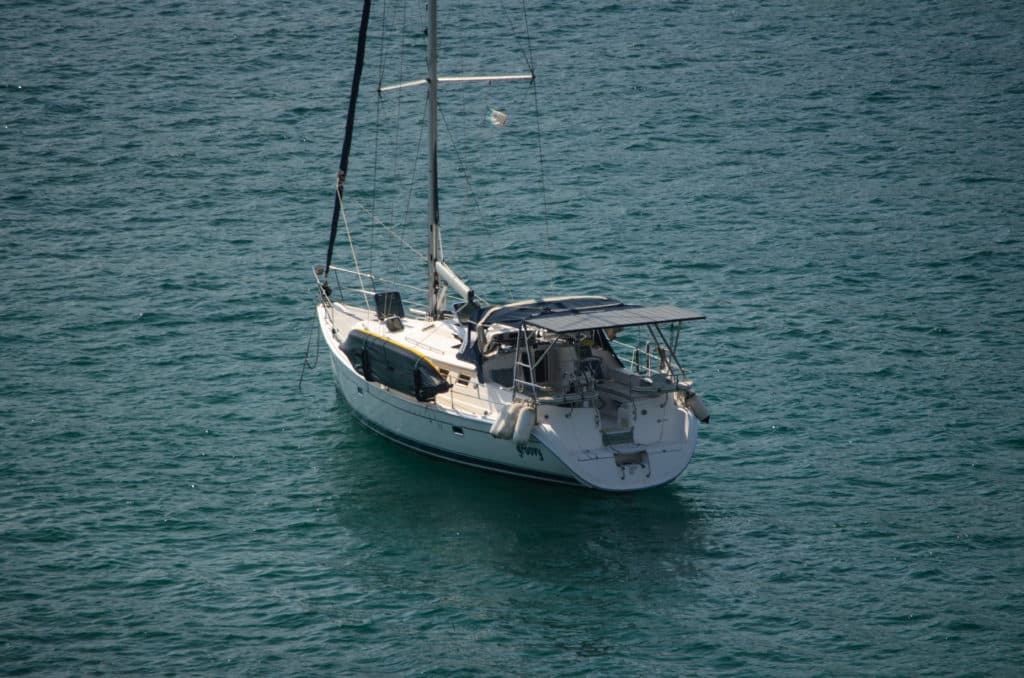
During our nearly four-year cruise of Mexico, my husband, Mark, and I lived almost exclusively on 555 watts of solar power charging a 640-amp-hour house battery bank. We anchored out virtually every night aboard our 2008 Hunter 44DS, Groovy , and relied on the sun for power. During one 10-week stretch, while we waited for a replacement engine alternator to arrive, our boat’s solar panels were our sole source of power. We had no backup charging system to turn to, and yet we lived and sailed comfortably the entire time. Mounting solar panels on a sailboat was not difficult, but a few key decisions made a huge difference in how effective our panels were.
A solar-power installation on a sailboat is made up of two independent systems: one system to charge the batteries, and another system to provide 120-volt AC power for household appliances. In the charging system, the solar panels convert sunlight into electrical current and deliver it to the batteries via a solar charge controller. Similar to a voltage regulator, the charge controller acts as a gatekeeper to protect the batteries from receiving more current than they need as they are being charged. In the AC power system, an inverter or inverter/charger converts the 12-volt DC power in the battery into 120 volts AC whenever it is turned on.
Panel Positioning and Wiring Considerations
One of the biggest challenges for sailors installing solar power on a sailboat is finding a place on the boat where the panels will be shaded as little as possible. Just a few square inches of shade on one panel can render that panel all but inoperable. Unfortunately, between the mast, radome, spreaders and boom, shadows cross the deck all day long, especially as the boat swings back and forth at anchor.
What’s worse, if the panels are wired in series rather than in parallel, this little bit of shade can shut down the entire solar-panel array. When we installed solar power on Groovy , we had already lived exclusively on solar power in an RV for over two years. Our RV solar panels had been wired in series, and we had witnessed the array shutting down current production when just half of one panel was shaded.
Choosing whether to wire the panels in series or parallel on a boat affects the wire gauge required, which is why many solar-power installers lean toward wiring the panels in series. Panels wired in series can be wired all the way to the solar charge controller with a thinner-gauge wire than those wired in parallel. This is because the voltage of panels wired in series is additive, while the current remains constant, so the current flowing is just that of a single panel. In contrast, the current flowing from panels that are wired in parallel is additive, while the voltage across them is not. This means that in a parallel installation, the current going to the charge controller is several times higher and requires much thicker cable to avoid any voltage loss over the length of the wire.
Not only is thinner-gauge wire less expensive, but it is also more supple and easier to work with, making the job of snaking it in and around various crevices in the boat and connecting it to the solar charge controller much less of a struggle. Thus the choice between series and parallel wiring boils down to a trade-off between system performance, expense and ease of solar system installation.
Luckily, the size of the wire can be reduced if higher-voltage solar panels are chosen. Since watts are determined by multiplying volts by amps, a higher-voltage panel that generates the same watts as a lower-voltage panel will produce less current. Therefore, selecting nominal 24-volt panels instead of 12-volt panels allows for the use of thinner wire sizes no matter how they are wired.
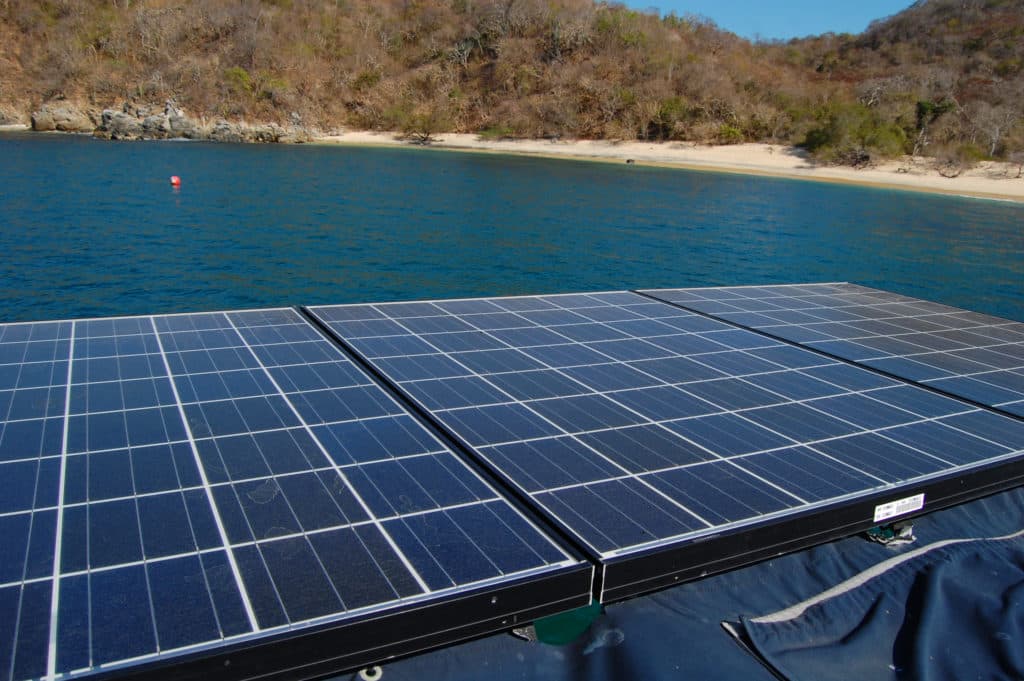
Our Marine Solar Panel Design Choices
In our installation, we decided to mount three 185-watt, 24-volt (nominal) Kyocera solar panels high above the cockpit, well aft of the boom, as far away as possible from potential shade. Our Hunter came with a big, solid stainless-steel arch, and we turned to Alejandro Ulloa, a brilliant metal fabricator at Baja Naval Boatyard in Ensenada, Mexico, to build a polished stainless-steel solar-panel arch extension onto the existing structure. He designed the arch extension with integrated telescoping davits to hoist our dinghy as well as support the solar panels. These davits were strong enough — and the lines and blocks had enough purchase — that either of us could lift our light Porta-Bote dinghy with its 6-horsepower outboard without a winch.
We spaced the panels about a half-inch apart and wired them in parallel. Using two twin-lead wires, we snaked the three positive leads and one common ground down through the inside of the arch tubes so they wouldn’t be visible, and placed wire loom over the exposed wires under the panels.
The junction points for the three parallel panels were on positive and negative bus bars inside a combiner box, all mounted in a cockpit lazarette. Inside the combiner box, we installed three breakers, one for each panel. This gave us the ability to shut off any or all of the panels if we needed to (we never did).
We mounted a Xantrex solar charge controller (model XW MPPT 60-150) in a hanging locker, as close to the batteries as possible, in a spot where it was easy to monitor and program. We ran twin-lead wire from the combiner box to the charge controller and from there to the batteries.
Our boat came with three new 12-volt Mastervolt 4D AGM house batteries, all wired in parallel, for a total of 480 amp-hours of capacity. We wanted a bigger house battery bank, and because it is best for the age, type and size of the batteries to be matched, we added a fourth new Mastervolt 4D AGM house battery, which brought our total to 640 amp-hours. Our batteries were installed at the lowest point in the hull, below the floorboards, and they ran the length of the saloon, from just forward of the companionway stairs to just aft of the V-berth stateroom door.
The best way to charge a bank of batteries that are wired in parallel is to span the entire battery bank with the leads coming from the charge controller. We did this by connecting the positive lead from the charge controller to the positive terminal of the first battery in the bank, and the negative lead from the charge controller to the negative terminal of the last battery. By spanning the entire bank, the batteries were charged equally rather than having the charging current focused on just the first battery in the bank.
We feel that AGM batteries are superior to wet cell (flooded) batteries because they can be installed in any orientation, don’t require maintenance, can’t spill (even in a capsize), and charge more quickly. Our Mastervolt batteries, like almost all AGM batteries on the market, are dual-purpose, combining the very different characteristics of both deep-cycle and start batteries. Our batteries work well, but if we were doing an installation from scratch today, we would consider the new Trojan Reliant AGM batteries. These batteries are engineered strictly for deep-cycle use and have been optimized to provide consistent current and maximize battery life.
Our boat came with a Xantrex Freedom 2,500-watt inverter/charger wired into the boat’s AC wiring system with a transfer switch. The inverter/charger performed two functions. While the boat was disconnected from shore power, it converted the batteries’ 12-volt DC power into 120-volt AC power, allowing us to operate 120-volt appliances, like our microwave. When the boat was connected to shore power, it charged the batteries.
Because this inverter/charger was a modified-sine-wave inverter, mimicking AC current with a stair-stepped square wave, we also had a 600-watt pure-sine-wave inverter to power our potentially more sensitive electronic devices. We chose Exeltech because its inverters produce an electrical signal that is clean enough to power medical equipment, and they are NASA’s choice for both the Russian and American sides of the International Space Station. For simplicity, rather than wiring the inverter into the cabin’s AC wiring, we plugged ordinary household power strips into the AC outlets on the inverter and plugged our appliances into the power strips. Like the charge controller, the inverter must be located as close to the batteries as possible. Ours was under a settee.
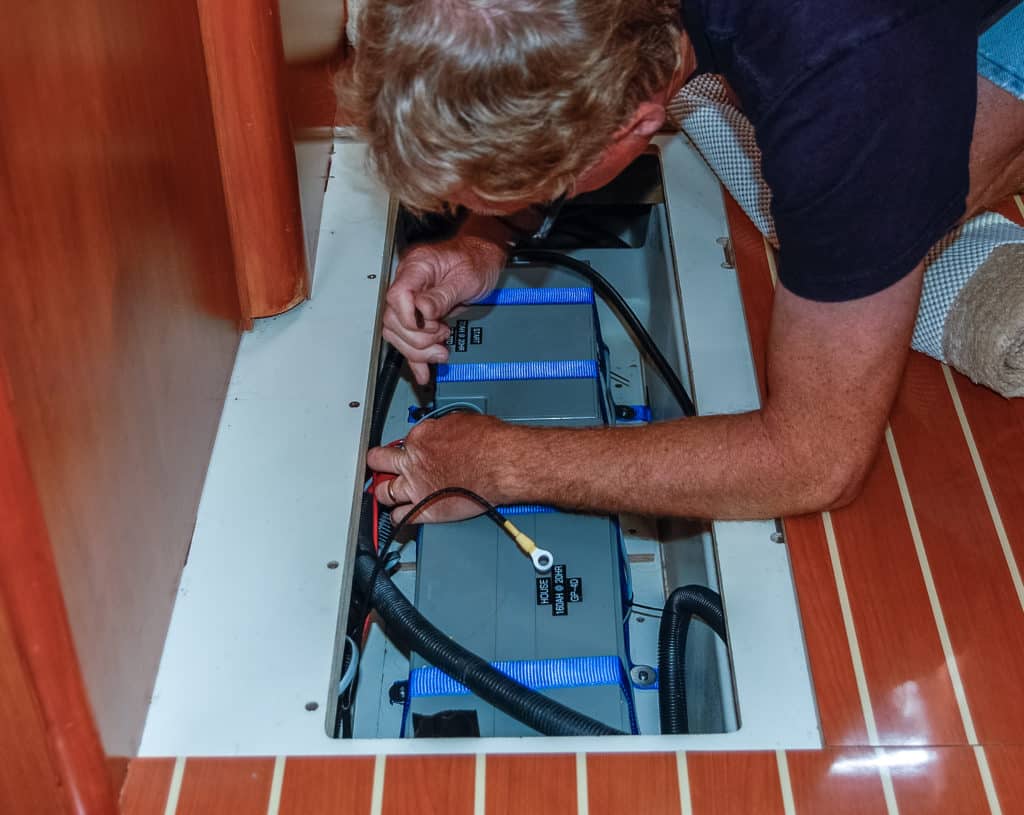
Shade’s Impact on Sailboat Solar Panels
Once our solar installation was completed on our sailboat, we closely observed the effects of shade on our solar-panel array. We were often anchored in an orientation that put the panels in full sun. Just as often, however, we were angled in such a way that shade from the mast and boom covered portions of our panels. It was fascinating to monitor the solar charge controller’s LCD display whenever the sun was forward of the beam — the current from the panels to the batteries fluctuated up and down as we swung at anchor.
Taking notes one morning, we noticed that the charging current was repeatedly creeping up and down between 9.5 and 24.5 amps as the boat moved to and fro. When the entire solar-panel array was in full sun, it generated 24.5 amps of current. When we moved so the mast shaded a portion of one panel, the array generated 15 amps. When it shaded portions of two panels and only one was in full sun, the array produced just 9.5 amps. Of course, it would have been preferable to see a steady 24.5 amps all morning, but this sure beat watching the current drop to zero whenever a shadow crossed a panel.
We discovered that shade makes a huge impact while sailing, too. Surprisingly, it is far worse to have the panels shaded by the sails than to have the panels in full sun but tilted away from its direct rays. One afternoon, we noticed that while we were on a tack that tilted the panels away from the sun, they generated 24.5 amps of current, whereas on a tack where the panels were tilted toward the sun but two of the three were partially shaded by the sails, the current dropped to a mere 10 amps.
Reflections On Our Solar Panel Installation
A wonderful and surprising side benefit of our large solar panels and arch system was that the setup created fabulous shade over the jumpseats at the stern end of the cockpit. Our metal fabricator, Alejandro, placed a support strut at hand-holding height, and sitting in those seats feels secure and comfortable while sailing, no matter the conditions.
After living on solar power for eight years of cruising and land-yacht travel, we’ve learned that you can never have too much solar power. Groovy’s 555 watts was enough to run all our household appliances as needed, including our nearly 4-cubic-foot DC refrigerator, two laptops, a TV/DVD player, and lights at night. However, it was not quite enough power to run all that plus our stand-alone 2.5-cubic-foot DC freezer during the short days and low sun angles of the winter months without supplemental charging from the engine alternator every few days. For the 10 weeks that we did not have a functioning alternator, our solution was to turn off the freezer, which enabled our batteries to reach full charge every afternoon.
Solar power made a world of difference in our cruise. Not only did it allow us to live comfortably and with ample electricity for weeks on end when our engine alternator went on the blink, but as a “set-it-and-forget-it” system, it also gave us the freedom to anchor out for as long as we wished without worrying about the batteries. In our eyes, the solar-panel arch enhanced the beauty and lines of our boat, giving her a sleek and clean appearance. It was true icing on the cake to discover that the panels and arch system also provided much-needed shade over the cockpit and helm from the hot tropical sunshine. If you are preparing for a cruise, consider turning to the sun for electricity and outfitting your sailboat with solar power.
The Installation:
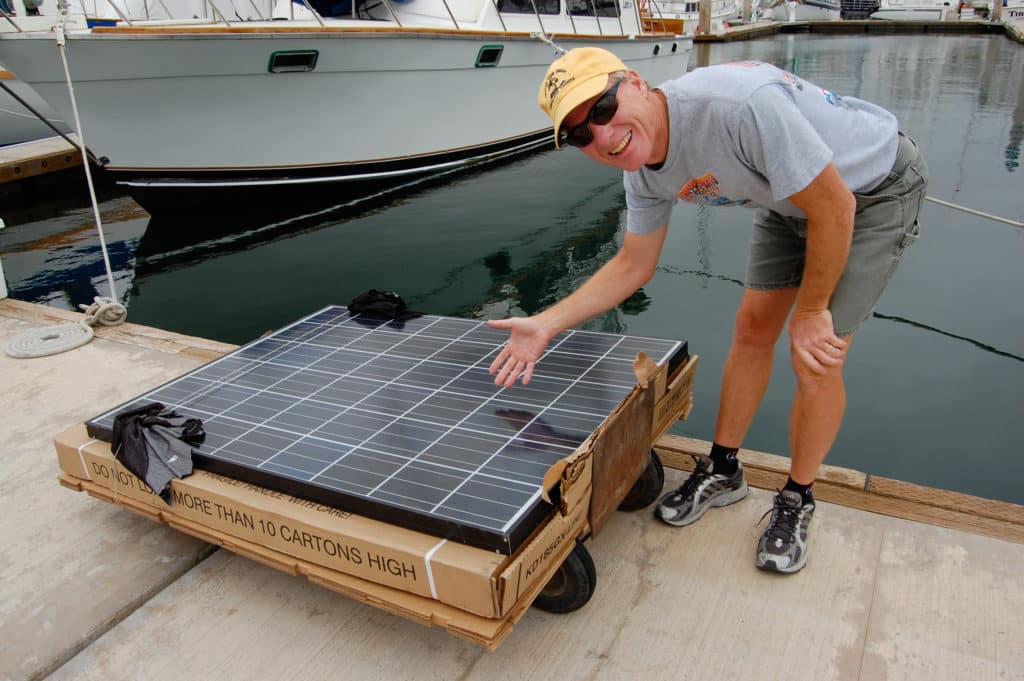
Emily and Mark Fagan offer cruising tips and share their stories and photos on their website, roadslesstraveled.us . They are currently enjoying a land cruise across America aboard an RV.
- More: DIY Sailboat Projects , green sailing , How To , installations , Refits , Sail Green , solar , solar panel , Upgrades
- More How To

Grease the Wheels of Your Boat: A Guide to Proper Lubrication

A Bowsprit Reborn: A DIY Renovation Story

Rigging Redo: Our Switch to Synthetic

Top Tools for Sailboat Cruising: Must-Have Gear for 2024

Galápagos: A Paradise Worth the Paperwork

Around Alone

- Digital Edition
- Customer Service
- Privacy Policy
- Terms of Use
- Email Newsletters
- Cruising World
- Sailing World
- Salt Water Sportsman
- Sport Fishing
- Wakeboarding
Solar power
Electric boats.
- electric boat
I drove a rare solar-electric yacht to test clean-sea propulsion, here’s how it went
While we at Electrek often tend to focus on electric vehicles taking over roads, it’s important to remember that our inevitable abandonment of fossil fuels stems to all modes of transportation, whether it’s by land, air, or even the sea . I recently had the opportunity to set sail on Sunwater Marine’s Ramblin’ Rose , a 40-foot sailing yacht powered by solar panels and electric propulsion. It’s one of the only vessels of its kind on the West Coast.
Sunwater Marine is a San Diego-based nautical transportation company with a keen focus on spreading the benefits of renewable energy and electric propulsion to sea dwellers.
It was founded by president James Richmond in 2020, amid the global pandemic. Richmond had a little more free time to search for a boat for blue water cruising to which he could add solar.
James has been sailing for over 50 years, and has nearly 40 years of experience in the renewable and energy-efficiency industry.

He soon found a 2015 Leopard 40 Catamaran and initially planned to simply add solar panels for an electric range and an energy-efficient water maker.
However, James soon discovered viable options for electric propulsion, and began researching the possibility of converting his new yacht to be be solar-electric.
The result is the Ramblin’ Rose , a catamaran that can haul 12 passengers and sleep up to nine. It also happens to be one of the only solar-electric yachts in the West Coast.
I got the chance to take the solar-electric yacht out of beautiful Coronado and test the technology out myself.

The Ramblin’ Rose solar-electric yacht
As previously mentioned, Sunwater Marine’s Ramblin’ Rose is centered around a Leopard 40 catamaran, built by Robertson & Caine in South Africa. Richmond then put an additional $100k into a renewable energy conversion, equipping the yacht with solar panels, and electric motors.
While the original catamaran came with some traditional solar panels, Richmond’s experience in renewable energy told him that would not suffice for his solar-electric yacht.
He added lighter and more flexible solar technology from Sunflare , the first company to successfully mass-produce thin, durable CIGS (copper indium gallium selenide) solar panels.
The Sunflare panels on the Ramblin’ Rose operate individually with their own bypass diode, so if one is shaded (by the sail for example), the rest still work.
Richmond also separated the solar panels into three separate zones, so if one side of the boat is shaded, the other two are still harnessing the sun’s power back into the boat’s batteries.
He also showed me how durable these advanced solar panels were, as I was able to walk around on top of them without worrying about breaking any glass or ruining them.
The panels help charge the electric yacht’s battery packs while out sailing and indicate to the captain when they are doing so.
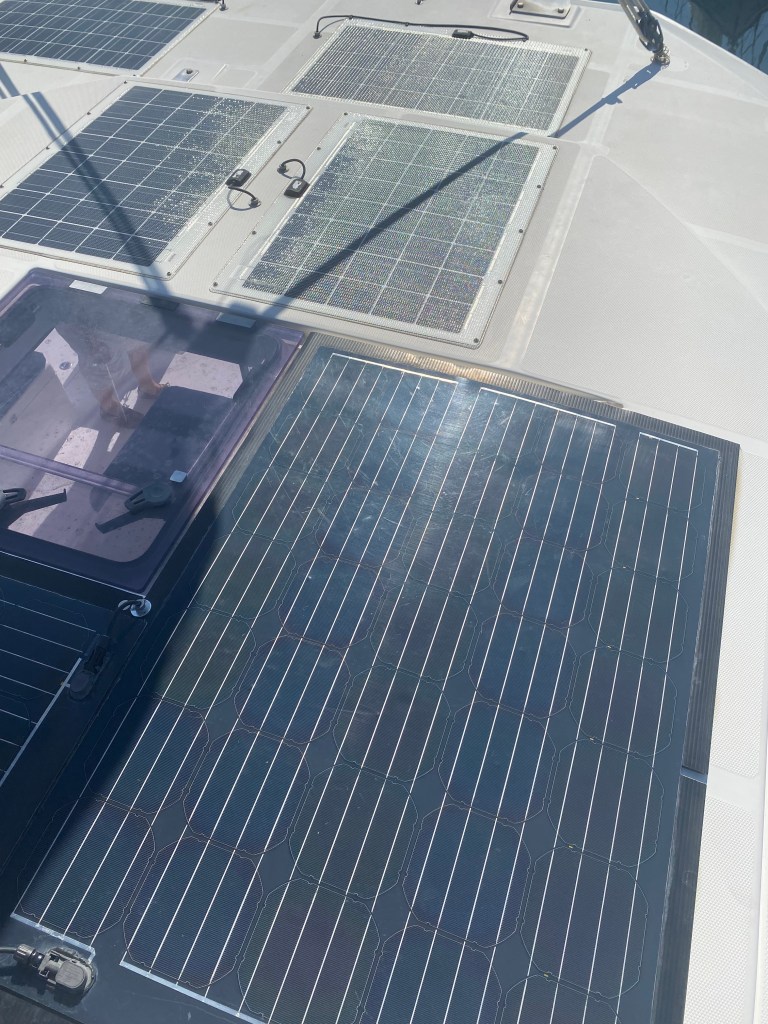
Electric propulsion and battery packs
To help power this vessel in and out of the marina and on the sea, Sunwater Marine’s president researched electric propulsion systems around the world, and decided that OCEANVOLT was the best option.
The solar-electric yacht now features two OCEANVOLT 15 kW ServoProp sail drives , utilizing unique propeller blades that can change pitch to optimize efficiency and even regenerate power.
The software controlled variable system adjusts the pitch of each of the propeller blades automatically, so that the power generation and output are always optimal. This is much more efficient than traditional fixed propellers.
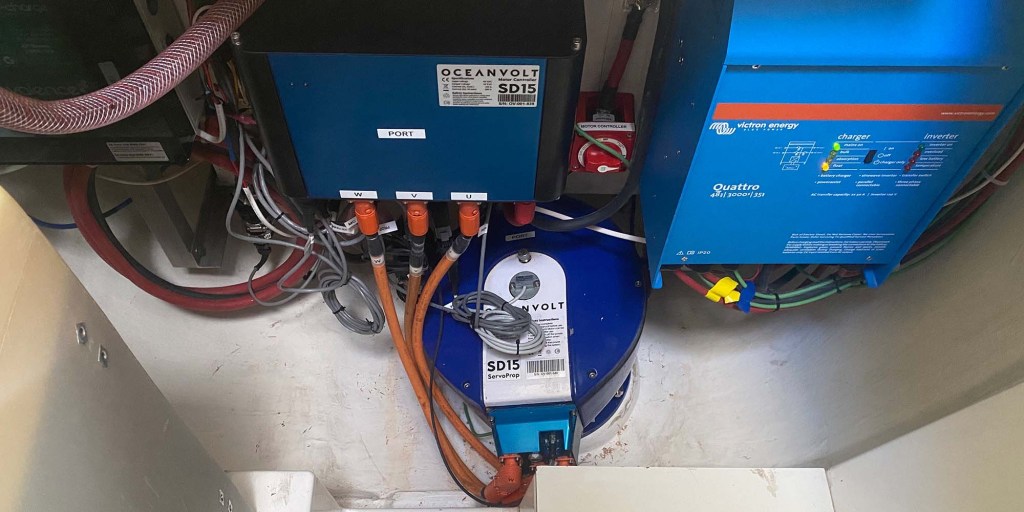
The electric propulsion is powered by a 48 volt system, meaning it’s safe to touch without electrical shock (an ideal situation for maritime fun).
Each electric motor on the yacht is powered by a bank of 12 Lithium Iron Phosphate (LFP) batteries on each side, 24 total. The batteries provide 21 kWh of power on each side of the vessel, 42 kWh in total.
Richmond explained that he positioned each battery pack eight inches off the bottom of the boat, too, so if any water were to come in, the batteries would still be OK. Furthermore, the captain showed me backup storage of eight additional batteries should anything go awry at sea.
The status of each and every battery is monitored 24/7 by a supervisory battery management system (BMS) that will shut the battery bank down, should any individual battery begin to malfunction. Fire is not something you want on a boat, despite being surrounded by water.
Additionally, the system was implemented to safely operate minimal electric functions under any conditions, so if the electric yacht were to tip over, there would still be power to send a distress signal.
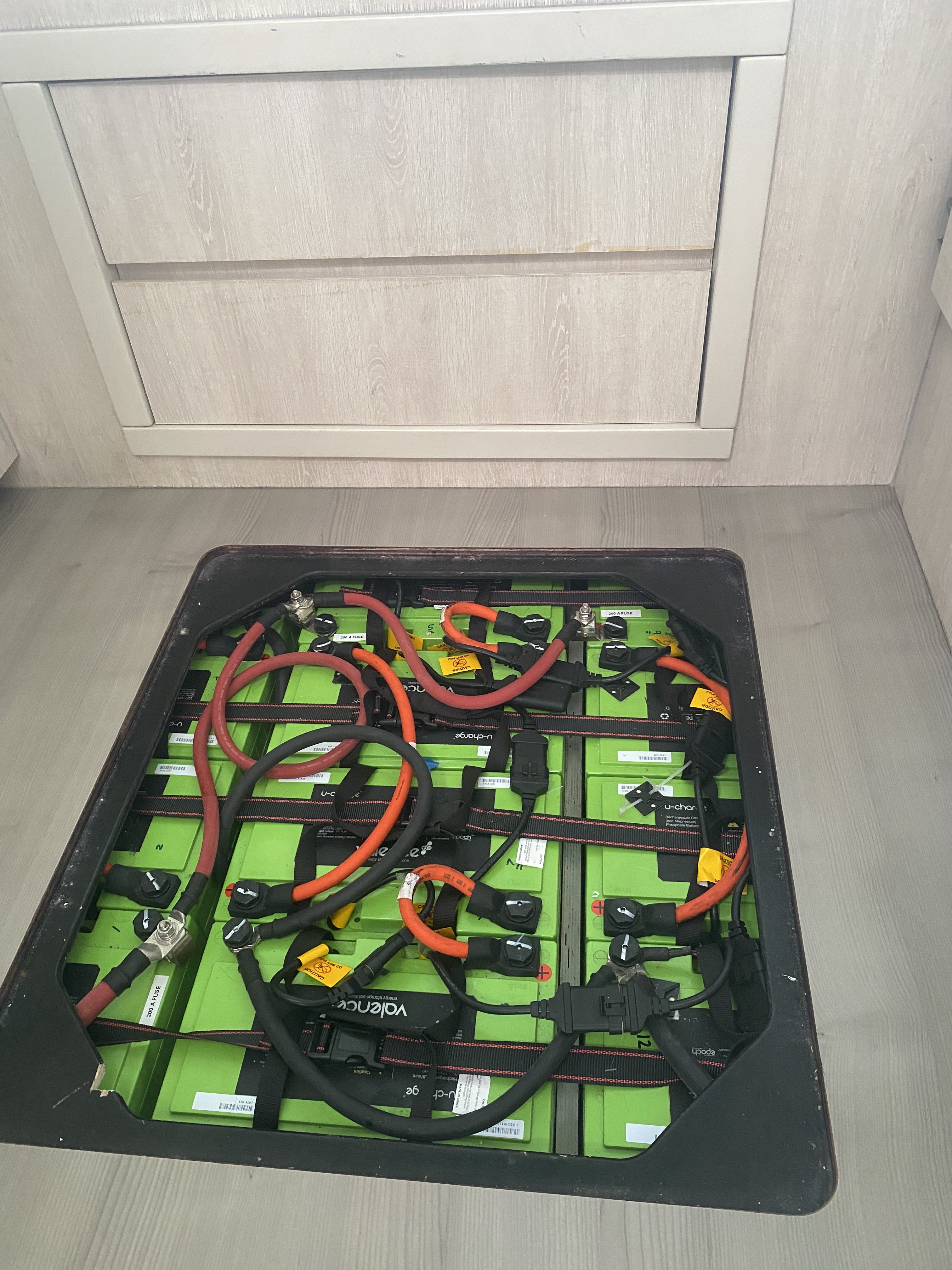
Thoughts on the future of electric propulsion
After manning the helm of the the Ramblin’ Rose , there is a lot to be excited about for the future of electric propulsion at sea , especially on a gorgeous yacht.
The ride itself was eerily smooth and quiet compared to diesel motors, with zero vibration throughout the boat. If you didn’t look back and see the wake of the electric motors, you might not even notice the yacht was being propelled.
There is a lot of potential in electric propulsion, especially as it pertains to propellers than can remotely change their angle like the OCEANVOLT ServoProps. This makes reversing the electric yacht in particular, much easier for captains compared to fixed props built to push forward.
The ability to set sail and regenerate power from the propellers is also a huge perk and pairs nicely with the advanced solar panels. Plus, you always have shore power as a backup when you’re in a pinch.
From what I’ve seen, the biggest hurdle looking ahead will be battery capacity, and providing enough stored energy to power the electric propulsion systems on the yacht.
The solar panels do help a lot, but it’s a relatively slow process. Smaller, lighter battery options will be crucial for longer distances at higher speeds at sea someday. In the meantime however, we still have sun and wind to pick up the slack.
Currently, the range and top speed are still limited by this lack of surplus energy below deck. We didn’t take the Ramblin’ Rose above 7.5 knots (~8.6 mph) because we didn’t want to burn through all our battery life (that was also in respect to the charter setting sail after us that day).
The solar-electric yacht still has diesel motors onboard for emergencies, but Sunwater Marine’s founder agreed with me that we’d like to see a day when those motors are not needed at all. Unfortunately, the technology is not quite there yet.
Luckily, people like Richmond and Sunwater Marine are using their knowledge and resources (and personal funds) to figure this stuff out for the masses, while spreading the word about electric propulsion. It has become a genuinely viable option at sea, even if it is only in support of other forms of propulsion like sailing for now.
If you’re ever visiting the San Diego area, I highly recommend reaching out to Sunwater Marine and chartering the Ramblin’ Rose , or one of the other solar-electric yachts Captain Richmond is working on.
FTC: We use income earning auto affiliate links. More.


Scooter Doll is a writer, designer and tech enthusiast born in Chicago and based on the West Coast. When he’s not offering the latest tech how tos or insights, he’s probably watching Chicago sports. Please send any tips or suggestions, or dog photos to him at [email protected]

Manage push notifications


9 Best Solar Panels for Sailboats
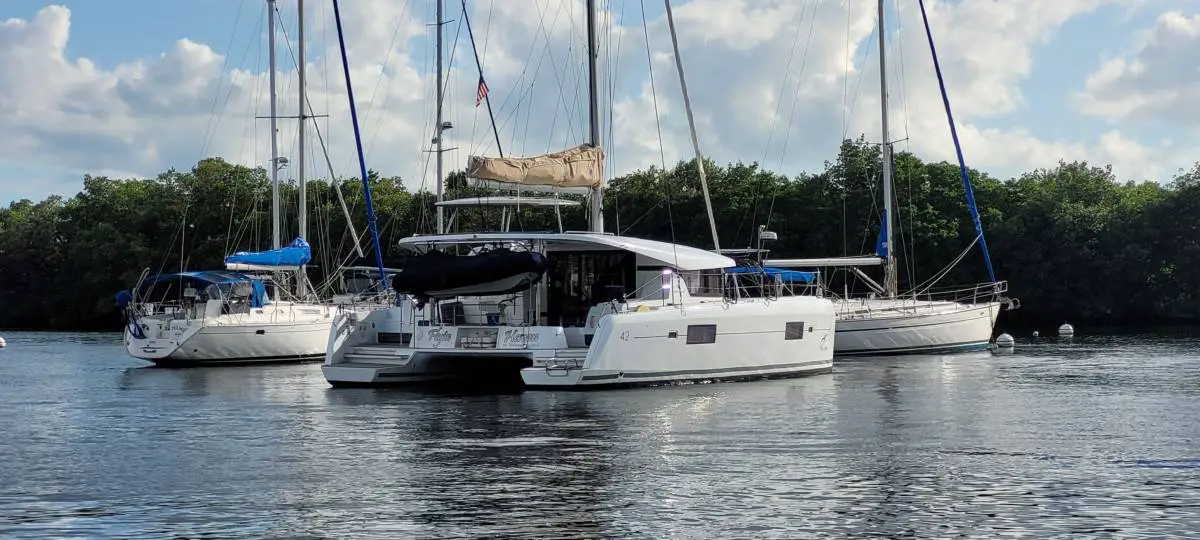
As an Amazon Associate, we earn from qualifying purchases. We may also earn commissions if you purchase products from other retailers after clicking on a link from our site.
Solar panels have become game changers when it comes to supplying power while off the grid. Marine solar panels can charge anything from batteries to computers to bigger electronic appliances. What are the best solar panels for sailboats?
The 9 best solar panels for sailboats are:
- Renogy Flexible Solar Panel
- Newpowa Solar Panel
- SunPower Flexible Sol ar Panel
- Eco-Worthy Off-Grid Solar Panel
- Rich Solar Polycrystalline
- Topsolar Flexible Solar Panel
- HQST Monocrystalline Solar Panel
- WindyNation Solar Panel Complete Off-Grid
- DOKIO Solar Panel Kit
This article will explore everything you need to know about the best marine solar panels.
Table of Contents
Solar Panels on Sailboats: An Overview
Before exploring the best solar panels, it is helpful to consider how solar panels on sailboats work and how many you need. Solar panels sit on different parts of a sailboat’s surface and absorb the sun’s rays, converting them into energy. This energy is used to power chargers, fridges, cooking stoves, and other electronics you need for self-sufficient sailing.
Worth noting is that today we will only discuss solar panels and not the batteries, which of course is an essential part of a complete system; we will also not discuss charges or charge controllers.
The products in this post will get you started in the right direction, but if you’re looking for a high-output system, then I suggest you contact someone that can help you calculate your energy requirements.
How Many Solar Panels Do I Need for My Sailboat?
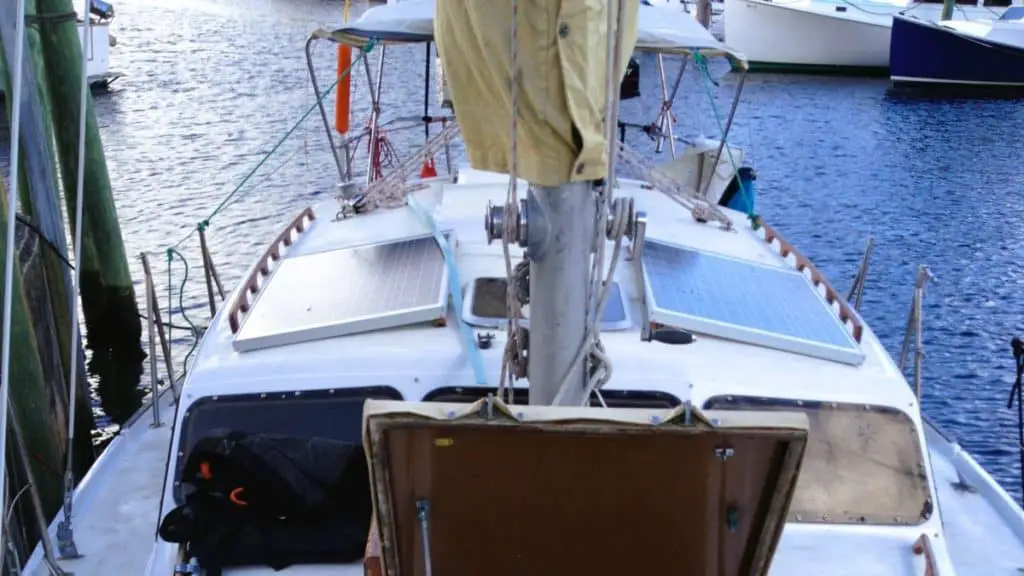
You will need between 2-8 solar panels for your sailboat. The exact amount depends on your sailboat’s space and how many electronics you need to power. Most solar panels can absorb between 100-300 watts per hour. On average, you will need approximately 1500 watts of power each day.
If your solar panels absorb 1500 watts daily, here’s what they can power on your sailboat:
- A laptop charger
- A microwave
- A coffee maker
- An induction cooker
If you want to power more heavy-duty electronics like a washing machine or a television, look for solar panels that absorb 400 watts. For heavy-duty electronics, try installing 5-8 solar panels.
Flexible vs. Rigid Solar Panels
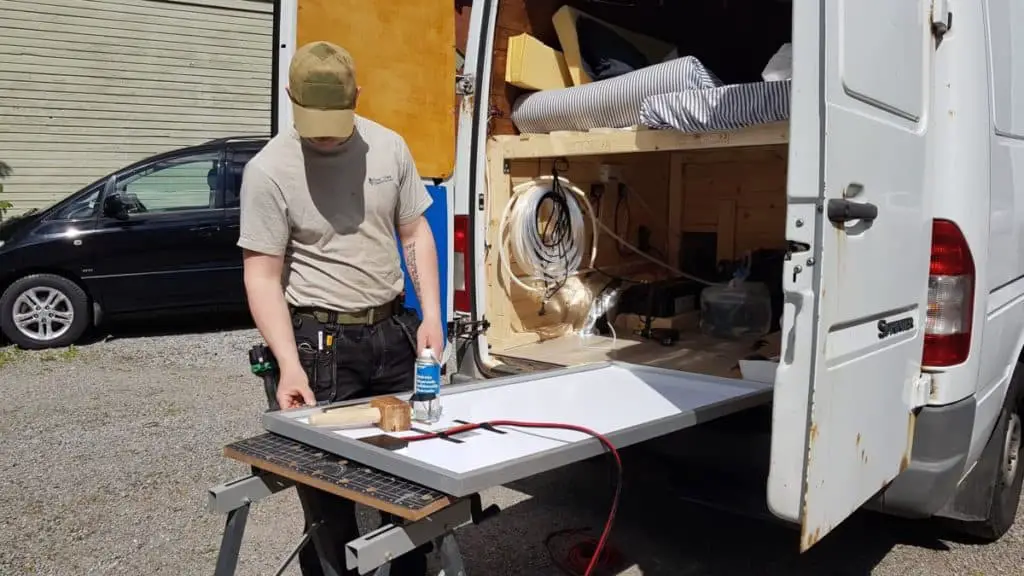
The three main types of solar panels are rigid panels, flexible panels, and semi-flexible panels.
Rigid panels are surrounded by aluminum and made with sturdy tempered glass. They are resilient against various weather conditions but require flat space to install.
Semi-flexible panels can be slightly bent to fit the shape of the installation surface. However, they can’t absorb a lot of power.
One very common type of solar panel used on boats is the flexible panel . Flexible panels are thin and lightweight, and, as their name suggests, they can be added to a wide variety of surfaces.
Here are the pros of flexible panels:
- They are thin and light. Flexible panels are approximately one-eighth the weight and size of rigid and semi-flexible panels. This allows you to add them to various sailboat sizes and surfaces. It also reduces the load on your sailboat.
- They are easy to install. Flexible panels are easy to work with and can be self-installed by following the instructions that come with the panels. Meanwhile, rigid and semi-flexible panels may require expert installations.
- They’re sturdy. Despite being light, flexible panels can bear a lot of pressure – you can easily walk over them.
However, there are also some drawbacks to using flexible solar panels:
- May fly away . As flexible panels are fragile, they can easily be dislodged and fly away, especially in strong winds.
- Vulnerable to scratches . While flexible panels can bear much weight, they may get scratched more easily. Over time this may affect their functionality.
- Not easy to reposition. Flexible panels are generally adhered to the surface of a sailboat using a specially prepared adhesive. Because of this, it is challenging to reposition the solar panels when there is a change of season.
- Less efficient. Flexible solar panels don’t convert energy to electricity or rigid panels. It may be harder to power heavy-duty appliances from a flexible solar panel.
How Many Panels Can I Fit on a Sailboat (Catamaran and Monohull)?
The amount of panels you can fit on your sailboat depends on the size of the panels and the surface space you have available.
You can fit at least two 400W panels on a Monohull and at least four on a Catamaran around 35ft in length. You will be able to fit 4-8 more solar panels if you add a solar panel bracket at the stern.
Renogy Flexible Solar Panel 100W
Renogy is a popular solar panel producer that designs high-quality solar panels. The Renogy Flexible Solar Panel is specially designed for marine vehicles, including sailboats.
Here are the best features of this solar panel:
- Flexibility . These solar panels are fragile, making them flexible and easy to mount on served surfaces.
- Easy to install. These are made with high-quality Monocrystalline, allowing them to be easily bent and easy to install.
- Lightweight. One solar panel weighs only 4 pounds, ensuring that no extra pressure or weight is displaced on your boat.
- Durability . User reviews have noted that these panels are highly durable and can last you a few years.
- Users have noted that these panels do not have the best outputs. They also can’t be stacked, which impacts their accessibility. To ensure that these panels can be connected, you may purchase extra extension cords.
Newpowa Rigid 160W Solar Panel
The Newpowa Right Solar Panel is a new design with a maximum power of 160W. It is weather-resistant and can be used on various surfaces and vehicles.
Here are the pros of the Newpowa Solar Panel:
- Weatherproof . The design features of this solar panel ensure that it survives under a range of different weather conditions. It has a heavy-duty frame preventing it from strong wind and waves. Its mainframe has a further layer of protection for the Junction box.
- Long warranty . Newpowa offers a 25-year transferrable output power warranty.
- Easy to install . These solar panels are made with mono cells and bypass diodes. Consequently, the solar panels can be immediately unpacked and are ready to install.
- High wattage. As these solar panels have 160 Watts of power, you need less of them to power all the devices on your boat.
- If you are planning on buying the Newpowa Solar Panel, you should note that they only make rigid panels. As a result, you may find it to be difficult to install them on curved spaces.
SunPower 110W Flexible Solar Panel
SunPower’s Flexible Solar Panels are made with high-quality materials ensuring durability. They are especially ideal for sailboats as their warranty also covers saltwater damage.
Here are the standout features of the SunPower 110W Flexible Solar Panel:
- Flexibility . This solar panel can be bent up to 30 degrees, making it easy to install on various surfaces.
- Easily portable. These solar panels are incredibly lightweight (4.4 pounds or 2 kilograms) and can be easily uninstalled and transported.
- Extended warranty . SunPower offers a five-year warranty on power and a two-year warranty on the product. The warranty includes damage caused by saltwater which many other solar panel warranties do not.
- Some users have noted that the output quality of these solar panels deteriorates over time. However, you can use the extended warranty to address any quality deterioration.
ECO-WORTHY Rigid 25W Off-Grid Solar Panel
This is a rigid, 25-watt solar panel that is waterproof, making it ideal for your boat. It is highly durable and has inbuilt indicators that highlight the battery’s status. Its low output makes it only suitable for charging phones or smaller electronics.
Here are some notable features of the Eco-Worthy Solar Panel:
- Ease of use. This solar panel is easy to install and requires no maintenance.
- Warranty. Eco-Worthy offers one year of warranty on all of its products and free maintenance if needed.
- USB control. This solar panel is attached to a USB control panel, preventing it from overcharging and getting damaged.
- Waterproof. All solar panel parts are entirely waterproof and can handle exposure to both saltwater and freshwater.
Some of the drawbacks to this solar panel include:
- Low watt absorption. Unlike many of the other solar panels on this list, this one can only absorb up to 25 watts of power at a time. So, it can only power smaller devices like batteries.
- Instruction manual. Some users have noted that the instructions to set up the Eco-worth solar panel are confusing for beginners. If you have never installed solar panels before, it’s best to call in an expert to help.
RICH SOLAR 100W Rigid 12V Polycrystalline
This 100W rigid solar panel is designed to absorb energy even in low light conditions. It is easy to install and ideal for marine environments.
Here’s why you should consider buying Rich Solar Panels:
- Works well in low light. This solar panel has been tested in various low light conditions, including cloudiness and during sunrise and sunset. It is certified to be able to harvest energy in low light conditions.
- Extended warranty. Rich Solar Panels offers a 25-year warranty on limited power output and a five-year warranty on quality.
- Water and weatherproof . The Rich Solar panels have used selective design elements to ensure they are water-resistant. They have high transparency and are made with tempered glass to withstand high winds and water pressure.
- Cost-effective . These are significantly cost-effective, making it easy to equip your sailboat fully.
- While solar panels can easily resist strong winds and water, they can be vulnerable to hail. Hail storms can cause dents on the solar panels, which can eventually cause damage.
Topsolar Flexible 100W Solar Panel
Topsolar provides premium flexible solar panels that are easy to move and install. They are ideal for installing on water vessels like sailboats with waterproof materials.
Here are some of the pros of choosing the Topsolar Flexible Solar Panel:
- Flexibility . The arc radius of this solar panel is 16 inches (40 centimeters) and can be bent to fit several curved surfaces allowing your solar panel to harvest the most sun.
- Efficiency . These solar panels are made with ETFE (ethylene tetrafluoroethylene) materials. They are extremely energy efficient and can rapidly convert energy.
- Some users have noted that these solar panels don’t have as long a life as other panels. In addition, some panels may only be able to absorb up to 75 watts of power at a time.
HQST Rigid 100w Monocrystalline Solar Panel
This is a 100-watt solar panel that has been specially designed to perform well in low light. It is made with high-quality materials and is ideal for sailing boats as it is durable even in unfavorable weather conditions.
Here are the pros of installing the HQST Solar Panel:
- Durability . These solar panels are designed to withstand strong winds and snowfall. They’re made with tempered glass and aluminum and are resistant to corrosion, ensuring longevity.
- Testing and warranty. Each solar panel is quality tested before it is distributed. It also comes with a three-year warranty.
- Easy to install . While these are rigid solar panels, they have pre-drilled holes, making them easier to install.
WindyNation 100W Solar Panel Complete Off-Grid
As its name suggests, this solar panel is designed for off-the-grid living and is helpful if you need to access power when you’re in the middle of the sea.
Here is why you should consider the WindyNation Solar Panel:
- Includes a charge controller. This controller lets you quickly see the amount of power the solar panel has absorbed.
- High power. Several positive user reviews have indicated that this solar panel is highly efficient in absorbing and converting power.
- This solar panel is more expensive than many others on the market.
DOKIO 300W 18V Portable Solar Panel Kit
If you are looking for a heavy-duty solar panel, the Dokio Solar Panel Kit is excellent. It can absorb a lot of energy and power a wide range of appliances on your sailboat.
Here’s why you should consider this solar panel:
- Versatile and flexible. While this is a rigid solar panel, it can be folded, making it easy to transport and install.
- High efficiency. This solar panel is highly efficient at converting energy into power. As it absorbs up to 300 watts, you can install just two of these panels to get significant energy.
- Some users have noted that this solar panel does not work well in low-light conditions. You may want to have a backup solar panel for days when it’s rainy and windy.
Here are Some of My Favorite Catamaran Cruising Resources
Thank you for reading this article. I hope you found it helpful as you hopefully start your sailing adventures. Here are some resources that I use as a sailor that I hope you’ll also find helpful. These are affiliate links, so if you do decide to use any of them, I’ll earn a commission. But in all honesty, these are the exact things that I use and recommend to everyone, even my own family. Sailboats: If you’re looking for the best boat to suit your needs, I would recommend a catamaran. If you’re interested, I can show you the differences between catamarans and other types of sailboats .
Books: For getting started, I really like Cruising catamarans made easy . It is actually a textbook from the American sailing association; it is used to get a cruising catamaran certification. There are some other great books, and I have compiled a list of books about cruising catamarans that you will find useful.
Communication: Being out on adventures, whether it be sailing or climbing mountains, good communications are essential to being safe. I recommend two things Google fi (incredibly simple cellular data all over the world) and Garmin inreach mini (for text and voice in remote areas without cell coverage)
Sailing courses: Online sailing courses are great for beginners starting out their sailing career; it’s an efficient way of learning the basics of navigation, throttle controls, and maritime safety. I suggest starting with two free courses from NauticEd .
To see all my most up-to-date recommendations, check out this resource that I made for you!
Owner of CatamaranFreedom.com. A minimalist that has lived in a caravan in Sweden, 35ft Monohull in the Bahamas, and right now in his self-built Van. He just started the next adventure, to circumnavigate the world on a Catamaran!
Leave a Reply Cancel reply
Your email address will not be published. Required fields are marked *
Save my name and email in this browser for the next time I comment.
Recent Posts
Must-Have Boat Gear for Catamaran Sailors!
Sailing is probably the most gear-intensive activity I've ever done; there are so many decisions to be made about what gear to buy now, for tomorrow, and what to definitely never buy. The gear on...
6 Best Trailerable Trimarans For Bluewater and Coastal Sailing
Having a boat costs a lot of money, even when you are not using it, marina fees, etc. And once it is in the water most sailors never go very far from their "home marina" and sailing will be somewhat...
- Sign in / Register
- Comparison list
- Solar on the go
Picking the best solar panels for a sailboat: Buyer’s guide
- 18 Aug 2022

You might have already heard of brave sailors that conquer the oceans with nothing but wits and solar panels. For instance, this year 83-year-old Kenichi Horie became the oldest person to sail solo from the US to Japan on a solar-powered boat. These stories are inspiring, but picking panels for your boat yourself can be a small challenge in itself. That’s why we wrote a short article about the best solar panels for sailboats and how to recognize them.
Start from type of solar panels
When it comes to solar panels for sailboats, their weight and size matters more than with PV modules for residential systems. Efficiency is important but power — not that much, because the energy needs of a boat are relatively low. The first thing you’ll have to decide about your panels is their type.
Generally, you’ll choose between thin-film panels and monocrystalline modules. While polycrystalline panels are still around and they are indeed cheaper than mono panels, they are much less efficient, which means they’ll need more space and add more weight to your boat.

Thin-film panels are light and cheap
Thin-film or flexible solar panels bend well and they are very easy to install which makes them a great choice for boats with difficult configurations. Some sailors say that flexible panels are the best choice for fast boats because they don’t impact the aerodynamics of a vessel as much as rigid panels do.
The downside of flexible panels is their low wattage. If there are many appliances on board, you’ll need several panels and you’ll need to find the right place for each of them. They also age faster than rigid panels — a thin-film panel generally lasts for 10-15 years.
Monocrystalline panels are powerful and reliable
Rigid solar modules, monocrystalline and polycrystalline, are heavier and bulkier than thin-film panels. You can fix flexible panels with adhesives, but rigid panels require drilling. They are also more expensive than flexible panels.
On the other hand, monocrystalline panels are the most efficient type of panels which means that they provide more power for less space. Even one powerful mono panel can be enough for everything that you’ve got on board. They are also much more reliable and will survive any storm that is coming your way. A monocrystalline panel lasts for at least 25 years.
Panels for boat should be efficient and sturdy
The best solar panels for sailboats don’t have to be powerful, but they better be efficient — find the number in the datasheet. For rigid panels anything over 18-19% is fine. Panels also should be sturdy enough to withstand seastorms. You generally also want good shading tolerance since panels often get shaded by masts and sails. Finally, good performance in low-light conditions is appreciated.
Picking bifacial panels, 72/144-cell panels or larger, anything too powerful generally doesn't make a lot of sense. Performance at high temperatures matters less than it does with home systems. Warranties also play a lesser role. You won’t be able to make use of them because they generally have effect only for residential installations.
The markets of thin-film and rigid panels are different. Generally, a manufacturer of flexible panels doesn’t offer mono- or poly-panels. Canadian Solar, Q CELLS and Jinko Solar are good choices when it comes to monocrystalline modules for boats. Renogy , WindyNation and PowerFilm make fine thin-film panels.
Do the math before purchase
The amount of power for your boat depends on the number of appliances on your board. There are two main ways to determine the size of installation that you need. You can take a test trip and see how much of your battery’s charge you’ve spent in one day. You can also do the calculations manually: write down all the appliances on the board with their power rating and number of hours in use per day. You can read about it in detail in our article " How much solar power to sail the seas? " It doesn’t make sense to oversize a marine PV system, because all the excess power will just go to waste.
Keep in mind that adding photovoltaics doesn’t make your vessel a solar boat, unless you have a solar-powered motor. You can switch your boat to solar energy fully, especially if it’s small, but you’ll have to calculate your energy needs accordingly.

Once you’ve purchased your panels, you’ll have to install them properly. You can order professional service or do it yourself. The most popular places for solar panels on a boat are a stern rail, masts, deck and canvas. Thin-film panels can even go on the sails. Ideally, you want a place where panels wouldn’t be shaded by masts on any other parts of a boat.
List of solar panels for a sailboat
We’ve asked our engineer to pick the panels that would complement a small boat well. These are his choices:
ZNShine Solar ZXM6-NH120-370/M

Solar panels from ZNShine Solar are inexpensive and fit all kinds of applications, including boat systems. ZXM6-NH120-370/M provides 370 Watts of power with a 19.88% efficiency. It performs well in low-light conditions. Graphene coating increases power generation and allows self-cleaning. The only downside is a lower wind tolerance, compared to other models: it is rated to withstand 2400 Pa pressure which is comparable to 140 mph wind.
Mission Solar MSE345SX5T

MSE 345 is a simple solar panel for all kinds of applications, including boat installations. Mission Solar panels are manufactured in Texas. The module provides 345 Watts of power with 18.7% efficiency. It is certified for high snow (5400 Pa) and wind loads (4000 Pa). The model is resistant to salt mist corrosion.
Suntech STP 365 S

Suntech is a Chinese company that offers quality budget-friendly solar panels. The STP365S model stands out in line because of its great performance in weak light, such as cloudy weather and mornings. It is designed to withstand harsh weather conditions, and the module is certified to tolerate wind of over 170 mph. Half-cut design makes cells sturdier and improves shading tolerance. Overall, this panel earns a place among the best boat solar panels.

Andrey had been a news editor and freelance writer for a number of medias before joining A1SolarStore team. Climate change and its impact on people's lives has always been among his interests and it partially explains his degree in Philosophy and Ethics.
Point Zero Energy solar generators review: Titans
Solar monitoring systems: All under control
Inergy solar generators review: Taking charge
AC vs DC-coupled solar battery systems: Pros and cons
How to clean RV solar panels
Learn about the latest arrivals and discounts first!
By clicking "Subscribe", I agree by electronic signature to: (1) receive marketing and other texts and messages from A1SolarStore, directly or from third parties acting on its behalf, at the email address I entered above; (2) the Terms and Conditions ; and (3) the Privacy Policy .

- Green Propulsion
- Renewable Energy
- Energy efficiency
- Sustainable materials
- Eco Insights
- News & Events
- Sunreef News Magazine
- Press About Sunreef

- 60 Sunreef Power
- 70 Sunreef Power
- 80 Sunreef Power
- 100 SUNREEF POWER
- Sunreef Ultima Range
- Sunreef 44 Ultima
- Sunreef 55 Ultima
- Sunreef 66 Ultima
- Sunreef 77 Ultima
- Sunreef 88 Ultima
- Sunreef fleet

- SUNREEF ZERO CAT
- SUNREEF 100
- Sunreef Fleet

- SUNREEF 35M
- SUNREEF 43M
- 49M SUNREEF POWER
- 210 Sunreef Power Trimaran
- Sunreef Explorer
- 40M SUNREEF EXPLORER
- 40M SUNREEF EXPLORER ECO
- 50M SUNREEF EXPLORER
- Superyacht Fleet
Solar Powered Yachts
Solar panels are a fundamental element of today’s quest for responsible energy generation. Used in households, commercial facilities, and power stations across the globe, they are also a vital source of energy for solar powered yachts. With significant progress made over the last years, photovoltaic technology has emerged as the natural energy source with the most exciting growth potential.
Thanks to photovoltaic cells, solar panels absorb sun radiation to generate direct current (DC). When sunlight reaches a solar cell, it causes silicon electrons to move. This motion will start the flow of electricity that is captured by wires and directed to an inverter. Inverter technology is then used to convert it to alternating current (AC) ready to power household appliances.
The solar power systems on solar powered yachts usually consist of solar panels, batteries, charge controllers and inverters. While batteries store the energy obtained from the solar panels, charge controllers prevent batteries from overcharging. Solar catamarans with house appliances on board will usually need to convert the DC energy into AC with the help of an inverter.
Sunreef Yachts produces solar panels in-house and uses a new (patent-pending) technology to integrate them within structural components. The panels are made of the industry’s most efficient cells with a peak performance of 24%.
Thanks to the solar cells’ outstanding flexibility, Sunreef Yachts’ solar panels can be mounted on any surface of the solar powered yacht. As a result, they are integrated with various areas on board, such as hull sides, mast, superstructure, bimini roof or bow terrace to maximize energy generation.
With a thickness below 1mm and weighing around 1,8 kg per square meter (average solar panels will weigh between 8 and 15 kg per square meter), they are one of the lightest solar power systems in the world. In addition, tests have proven that thanks to their advanced integration technique, Sunreef Yachts solar panels have a very high resistance to shock and abrasion. This allows them to be used on any surface, including hull sides.
EXPLORE OUR CATAMARANS
Sailing yachts, power yachts, superyachts, discover the green side of yachting.
SUBSCRIBE TO OUR NEWSLETTER
- Sailing Yachts
- Power Yachts
- Superyachts
- Making a Change
- Green Concept
Copyright © 2024 Sunreef Yachts . All rights reserved.
- Whistleblowing
- Privacy Policy

Sunreef Venture S.A.
Sunreef Yachts Shipyard
ul. Tarcice 6
80-718 Gdańsk, Poland
+48 58 769 77 77
Field test: PV Modules
A real world comparison between Mono, Poly, PERC and Dual PV Modules.
* This is a field test and the results are specific for this installation on this location please research which is the best solution for your own situation as the results can be different based on environmental influences.
Total solar yield as of 27/03/2023 when the results were reset: Mono: 9158 kWh Split-cell: 9511 kWh Poly: 9113 kWh Perc: 9471 kWh Perc-east: 1970 kWh Perc-west: 1730 kWh
Enjoy the sound of silence
Harnessing the power of the wind makes sailing an unforgettable experience. All you want to hear is the sound of the wind blowing and the waves breaking. But what is the best way to power the on-board electronics while the engine and generator are switched off? Victron combines energy storage and solar generation to provide the power you need. In absolute silence.
Whether you’re sailing away for the weekend or planning a trip around the world, big chance the very same Victron solution could support both. It’s the level of comfort that really determines your optimal solution aboard. With Victron you can power just about any plans, but as an example we illustrated ‘normal’ and ‘heavier’ power profiles in the below for the ‘average’ sailing yacht.
Consumption
- Power Profile
- Complete system
How much do you need?
A modern sailing yacht is packed with a lot of electrical equipment. Most things used to run the boat usually use DC, bigger (household) appliances need AC. When it comes to estimating power consumption, many just add up the Watts. Time is equally important. A microwave might use 1000 Watts, but only for 2 minutes. A fridge might consume as little as 50 Watts, but is turned on 24 hours a day.
For inspirational purposes we’ve outlined 2 system examples based on ‘normal’ and ‘heavier’ use.
1.2 - 2.4 kWh / day
'normal' and 'heavier' energy consumption. Read more
The microwave uses 1000W an hour but is only on for 2 minutes a day. 1000W / 60 x 2 = 0.03 kWh / 2 minutes
The fridge uses 50W an hour but is on the entire day (actually cooling ½ the day). 50W x 24hrs/2 = 0.6 kWh / day
Storage & conversion
How much energy should be stored.
Storing energy allows you to live of shorepower at sea or lets you use solar power harvested during the day over night. The inverter will convert the stored power to 230V. Sailing yachts typically experience long intervals between battery recharges, so your house battery should have a generous capacity. As a rule of thumb, we’re calculating with 48 hrs on board without shore power shore/engine/generator/solar power. Multiply the daily power consumption x days for even greater independency.
The storage capacity of a lithium battery should be two times the daily power consumption.
Due to its ±50% smaller discharge capacity, the storage capacity of a lead-acid battery should be four times the daily power consumption.
The inverter should be sized to handle the average load continuously and should match the expected peak power current, which our inverters handle very well (on average 2 x their continuous current).
Where does the power come from?
Sources of power, power profile.
Normal and heavier power profiles in kWh, based on the daily energy consumption, which should be in balance with the generation.
Storage batteries in Ah, double the capacity using lead-acid batteries.
It seems like your browser does not support the latest technologies. To see this section properly, consider using a modern browser.
System diagram
For a lithium and lead-acid battery based system.
How do the system design considerations translate into a robust system?
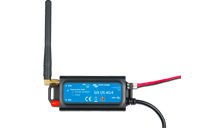
GX 4G modules

The professionals choice:

You’ll want to bring small devices on board for your trip. Or use household appliances like a microwave. These usually run of an AC outlet. Think of:
- Phone charger
- Refrigerator
Being able to plug-in these device saves you the trouble of finding a DC version.

Boat engines
Sailing yachts have one or two diesel engines (Catamarans) to get from harbour to horizon. The engines come with alternators to charge the engine batteries, drive fuel pumps, etc.
Once the starter batteries are recharged, the engines can also power the boat electrics and recharge the house battery. On bigger yachts you’ll find power hungry DC equipment such as anchor windlasses and bow thrusters. The engines have to be running before you can use them.
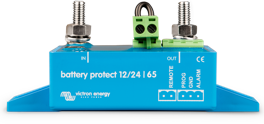
BatteryProtect
Discharging your battery too far will damage it. Adding a Victron BatteryProtect will disconnect the boat’s electronics when the battery voltage drops below a pre-set level. It will also automatically reconnect everything when the battery is sufficiently recharged.
There is more to a Victron BatteryProtect. The built-in shutdown delay ensures that vital electronics aren’t disconnected in error, i.e. when starting the engine causes a short drop in battery voltage.
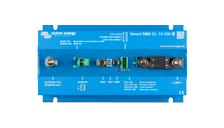
Battery Management Systems
Battery management systems take excellent care of Lithium batteries, protecting the individual cells of LiFePO4 batteries against over voltage, under voltage and over temperature and will shut down or reduce charging (VE.Bus products only) or disconnect the loads when this occurs.
Victron Energy offers several BMS options, in general the VE.Bus BMS and smallBMS signal separate devices to disconnect the charging (Inverter/Chargers, Cyrix-Li, DC-DC chargers) or disconnect the loads (BatteryProtect, Inverter/Charger), the modular Lynx distribution system features the Lynx BMS and other modules for more control over the DC busbar. For vehicles and boats all-in-one functionalities are available in the Smart BMS versions for Victron Lithium batteries, but also include current limiting to protect the alternator from overheating and BatteryProtect-like functionality to shut down the loads when pre-set critical battery conditions are met.
Victron Energy also offers full flexibility when it comes to selecting a third-party off-grid battery bank (and their BMS) of choice. A large number of well supported Lithium battery manufacturers can be easily integrated through the use of a mandatory GX-device. This flexibility enables our customers to perfectly match their off-grid needs for their unique power situation. When working with unsupported brands, a Victron Energy Battery Monitor is required to pass on accurate state of charge readings to the wider system.
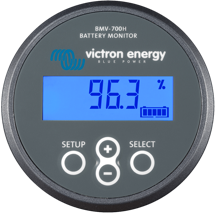
Battery Monitors
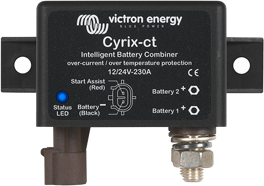
BatteryCombiner
The Cyrix BatteryCombiner is the only safe way to connect the house battery to the starter battery (to start your boat’s engines). With a BatteryCombiner you can charge the house battery from the alternator without running the risk of draining the starter battery (which always should be ready to go). When other sources of power are available (eg. shore/solar/generator power), the Cyrix BatteryCombiner will allow bi-directional charging from the house battery to the starter battery.
When the Voltages of the starter and house batteries are the same, use a Cyrix: its current rating should be equal or bigger than the current rating of the alternator. If the house battery is Lithium and the alternators Amperage is smaller than the house battery, or when the Voltages of the starter and house battery are different: use a Orion or Buck-Boost.

Boat Network
Keeping grips on all the systems on board can be a hassle. The solution: tie everything together in a single boat network using NMEA communication standards. Your boat network can include navigation equipment, tank senders, battery monitoring and much more. The status information can trigger alarms and shutdowns, adding to the safety on board. The Cerbo GX now supports the NMEA2000 out protocol, allowing you to monitor your boat’s network of systems from wherever you are.
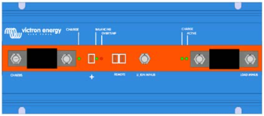
The BMS 12/200 is a dedicated battery management system (BMS) that protects Victron Smart 12,8V LFP batteries against deep discharges, overcharging and high temperatures with up to 200 Amps maximum DC current. When critical values are exceeded, the BMS acts immediately: loads are disconnected physically in case of a deep discharge and charging is stopped when there is a risk of overcharging. High temperatures trigger an immediate end to both charging and discharging.
This is the only BMS that can be directly connected to an alternator, protecting them from overload/overheating. This works with a combination of an AB fuse (rated in accordance with the expected max load current of the alternator) and an internal programmable input (which limits the input current electronically to 80% of the AB fuse).
Please check your manufacturer for the maximum charging current of your alternator and size AB fuses of the BMS 12/200 accordingly, see manual.
When different Lithium batteries & higher voltages are used, other solutions are needed, such as the VE.bus BMS and Lynx Ion BMS.

Boat Electronics
A sailing yacht is home to several electronic devices. These are all connected to the house battery. Think of:
- Boat control panel
- Log/depth sounder
- Chart-plotter or GPS
- Navigation lights
- Bow thruster
- Interior lighting
- Music player
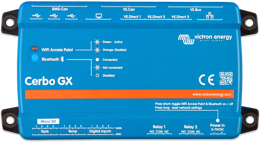
The Victron Cerbo GX is the communication-centre of your boat’s installation, allowing you to always have perfect control from wherever you are and maximises its performance. Simply connect through our Victron Remote Management (VRM) portal, or access directly, using the optional GX Touch 50 screen, a Multi Functional Display or our VictronConnect app thanks to its added Bluetooth capability.
The Victron Cerbo GX is an easy to use visual system. Instantly monitor the battery state of charge, power consumption, power harvest from PV, generator, and mains, or check tank levels and temperature measurements. Easily control the shore power input current limit, (auto)start/stop generator(s) or even set quiet periods to avoid starting the generator in the middle of the night. Change any setting to optimise the system, follow up on alerts, perform diagnostic checks and resolve challenges remotely. The Cerbo GX turns any power challenge into an effortless experience.
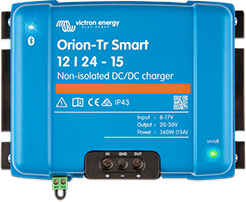
DC-DC chargers
DC-DC converters, or battery-to-battery chargers (converters with built-in charge algorithms) are used in dual battery systems, where the (smart) alternator and the start battery are combined with the service battery (of equal or different voltages) to charge it. They can also be used to charge applications that have dedicated batteries (eg. bow thrusters), or to power applications that have a voltage different than the service battery bank.
Most DC-DC chargers can be used in 12V or 24V systems and all are suitable for both lead acid and lithium batteries. Some DC-DC charger models can be parallel connected to increase the output current. DC-DC chargers are a perfect and safe solution to charge Lithium battery banks from smart alternators (and lead-acid batteries for that matter).
Charging lithium batteries from the alternator Most alternators cannot be directly connected to lithium batteries. A lithium battery will draw more current than the alternator can supply, which may result in permanent alternator damage. To not damage the alternator, current limiting is one of the options to stay within the safe zone of the alternator.
Victron offers multiple solutions to solve this problem, of which one of them are the DC-DC converters:
- DC-DC converters act as a current limiter between the alternator and the battery: the battery can be safely charged without blowing up the alternator.
- Victron also offers alternative solutions for dual battery systems powered by alternators. Some (smart) BMS products physically limit the current drawn from the alternator, in other systems, battery combiners might be a solid option. See the datasheets for more info.
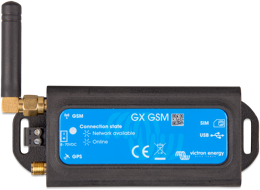
GX GSM Dongle
The Victron GX GSM is a 3G cellular modem that enables GX devices with mobile internet for the system and connection to the VRM Portal, allowing you to monitor your system from remote. When the boat is in range of a 3G network, it will send data to the VRM website and you can monitor the boat from your smartphone. The GSM module adds tracking the boat, recording your trips and putting up a geo-fence around the boat. You will get an alert via mail when the boat travels outside the geo-fence area.
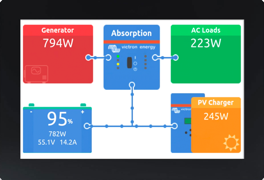
The Victron Energy Cerbo GX is the communication-centre of your systems installation, allowing you to always have perfect control from wherever you are and maximises its performance. The optional GX Touch 50 is a companion to the Cerbo GX, it’s five inch touch screen display gives an instant overview of your system and allows you to adjust settings in the blink of an eye.
Instantly monitor the battery state of charge, power consumption, power harvest from PV, generator, and mains, or check tank levels and temperature measurements. Easily control the shore power input current limit, (auto)start/stop generator(s) or even set quiet periods to avoid starting the generator in the middle of the night. Change any setting to optimise the system, follow up on alerts, perform diagnostic checks and resolve challenges remotely with the free Victron Remote Management (VRM) portal.
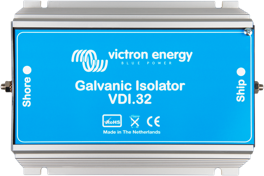
Galvanic Isolator
A galvanic isolator prevents electrolytic corrosion. The isolator is mounted directly behind the shore power connector on board. It blocks DC currents that might leak through the shore power earth terminal. These currents can cause corrosion to all metal parts under water, like the hull, propeller, shaft, etc. The galvanic isolator should have the same power rating as the incoming shore power.
It’s a misunderstanding that galvanic corrosion occurs only in metal and aluminium hulls. In fact it can occur on any boat as soon as a metallic part (the shaft and propeller) is in contact with water. Galvanic corrosion will quickly dissolve your sacrificial anodes, and attack the shaft, propeller and other metal parts in contact with water as soon as the boat is connected to the shore-side supply. It might therefore be tempting not to connect the ground conductor: this is however extremely dangerous because Ground Fault Current Interrupters will not work nor will a fuse blow in case of a short circuit to a metal part on the boat.
The safe option is to use a Galvanic Isolator for non-metal smaller boats, or use an isolation transformer for metal boats or boats with bigger systems.
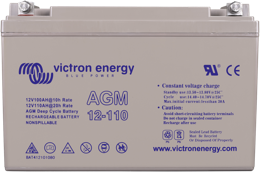
House battery
The house battery stores power for the boat’s electrical system. Sailing yachts typically have long intervals between battery recharges and the house battery should have a generous capacity.
For a house battery you can choose from two types: lead-acid and lithium. There are various reasons to favour one over the other. Here are a few common ones:
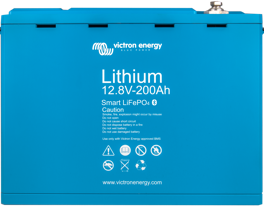
Inverter/Charger
The inverter/charger is the heart of the system. In the marina, it charges the batteries from shore power. While sailing it inverts the energy from the boat’s battery into AC power for household devices. The switch from charging to inverting and from inverting to charging is seamless.
- Victron inverter/chargers come with a handful of outstanding features:
- PowerControl: automatically manage battery charging to prevent an overload of the generator or shore power.
- PowerAssist: uses the battery as a buffer to assist the shore power during peak power demand.
- Perfect power: even sensitive devices run flawlessly on the pure sine wave power.
- High peak-power: use motorised equipment without overheating.
- Low self consumption.
For this power profile we would recommend:
We would recommend our Multiplus-II inverter/charger. If you have a generator on board you’ll need a Quattro inverter/charger, which has an extra input (shore power and generator).
We strongly recommend 24 Volts for new boats. The higher voltage is simply a better choice when it comes to meeting the power demands of a modern sailing yacht. If your boat’s system is based on 12 Volts, select a 12 Volts unit instead.
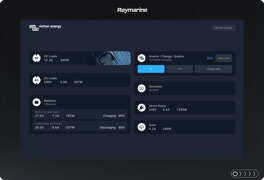
MFD GX Integration
The Victron integration between our GX range and several leading Multi Functional Display manufacturer brands enables you to easily connect an MDF to the heart of your power system such as the Cerbo GX, or the GX enabled Multiplus-II GX. Once connected you can easily monitor and control your boat’s power system, right on your Glass Bridge.
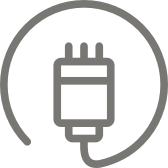
Shore Power
In the marina, the boat will be connected to shore power. Shore power recharges the batteries. It can also be used for maintenance and to run large AC loads.
Often shore power is limited in how much power you can draw, i.e. just 10 Amps. Berths with higher ratings might not always be available. Victron inverter/chargers allow you set a maximum shore power current. Now you can charge your batteries and turn on any equipment without blowing a fuse.
Sometimes shore power is less than perfect. You might run into voltage drops if you’re at the far end of the harbour. There could also be power surges, which could harm sensitive equipment on board. Victron’s inverter/chargers smooth out these problems and turn bad power into perfect power.
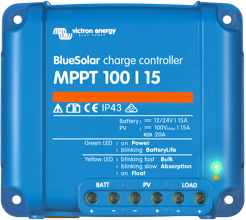
Solar charger
A solar charger- also called MPPT controller, harvests the power from the solar panels to charge the house battery. Solar chargers have the same charging cycles as our regular, fully automatic, battery chargers. When your boat is moored without shore spower, solar power is a great way to keep the batteries charged.
In a marine environment, the performance of solar panels changes constantly. Victron’s solar controllers use ultra fast maximum power point tracking to squeeze up to 30% more power out of your panels.
The rating of the solar charger is defined by the size of the solar panel. For solar panels of less than 150W or less, choose a 75/10 charger. If your solar panel produces between 150 and 220W, pick a 75/15 instead.
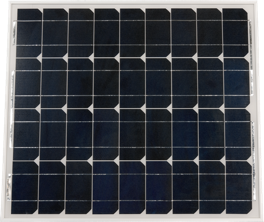
Solar panel
More and more sailing yachts area equipped with solar panels. After all, they extend the autonomy range without the noise of a diesel engine and… for free. Victron offers a wide range of small, highly efficient, solar panels that are just perfect for boats.
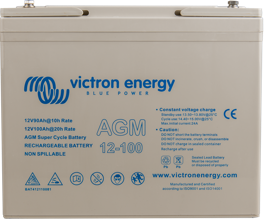
Starter Battery
The starter battery is needed to start your boat’s engine. These batteries are different from house batteries and engineered to deal with a large discharge current. The starter battery should always be ready to go. It’s best to isolate the important starter battery from all other electrical circuits on board, so it cannot be accidentally drained of power.
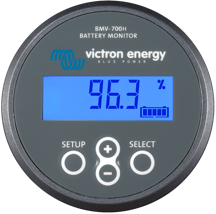
VE.Direct Bluetooth Smart dongle
The Bluetooth dongle enables you to use the VictronConnect app with VE.Direct enabled devices (without Bluetooth built-in). With the app you can have real-time insight and full control, and you can access all VE.Direct enabled devices such as the smaller VE.Direct inverters, the BMV 70x series battery monitors or MPPT solar controllers.
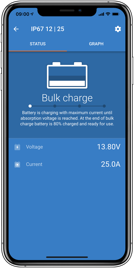
VictronConnect
All Victron products on your boat can be monitored and controlled from the palm of your hand. Just connect the VictronConnect App via Bluetooth and you’ll have direct access to values like battery voltage and current. You can also turn devices on or off, as well as change their settings.

VRM - Victron Remote Management
Monitor and manage.
Monitor and manage your Victron Energy systems from anywhere and catch potential issues early by setting alerts and alarms. With VRM you are always in perfect control from wherever you are.
VRM works with a GX-device such as the Cerbo GX with internet connection, the GlobalLink 520 or GSM LTE 4-g for smaller systems.
Monitor the battery state of charge, power consumption, power harvest from solar, generator and mains in real-time. Optimise the energy harvest and usage with history graphs and detailed analytical reports. Catch potential issues early by setting alerts and follow up on alarms to prevent definitive system failure.
Easily control the shore power input current limit, switch on the inverter, (auto)start/stop generators or even set quiet periods to avoid starting the generator in the middle of the night. With VRM you can change any setting, follow up on alarms, perform diagnostic checks and resolve challenges from wherever you are.
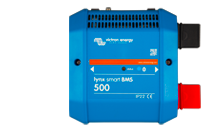
Lynx Smart BMS
The Lynx Smart BMS is a dedicated Battery Management System for Victron Lithium Smart Batteries (for non Victron Lithium batteries, see below). There are multiple BMS-es available for our Smart Lithium series of batteries, and the Lynx Smart is the most feature rich and complete option. Its main features are:
- Built-in 500A contactor, used as a fallback safety mechanism and also suitable as a remote controllable main systems switch.
- Battery monitor, indicating state of charge percentage and more data.
- Pre-alarm signal: provide a warning before the system shuts down due to -for example- a low cell.
- Bluetooth for use with our VictronConnect App, for setup and monitoring.
- Local and remote monitoring using a Victron GX device, for example the Cerbo GX.
Battery Management System
The dedicated battery management system (BMS) protects Victron Lithium Smart batteries against deep discharges, overcharging and high temperatures. When critical values are exceeded, the BMS acts immediately: loads are disconnected physically in case of a deep discharge and charging is stopped when there is a risk of overcharging. High temperatures trigger an immediate end to both charging and discharging.
Battery monitoring
Lynx Distribution system
Non Victron Lithium batteries
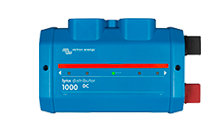
Lynx Distributor
The Lynx Distributor is a modular DC busbar, with locations for four DC fuses. It will monitor the status of each fuse, and indicate its condition with a LED on the front. When connected to a Lynx Smart BMS or Lynx Shunt, the status of the fuses will be visible in VictronConnect and VRM (when the Lynx Smart BMS is connected to a GX-device).
Multiple Lynx Distributors can be used to connect all the DC-loads and charge sources on one side of the BMS, on the other side, a Lynx Power In (without fuses) or another Lynx Distributor (with fuses) can be used to connect the battery bank to the modular busbar.
This product is part of the modular Lynx busbar system that also provides the Lynx Smart BMS, a dedicated Battery Management System for Victron Lithium Smart Batteries (for non Victron Lithium batteries, use the Lynx Shunt).
Power consumption will vary from yacht to yacht and from owner to owner, even on sailing yachts. Here are two examples - with a normal and a heavier daily energy consumption - of what an Optimal Energy plan for a sailing yacht could look like. Please note that many more factors come into play when designing and installing your optimal solution: your Victron Professional will gladly help you with that.
To see this detailed table and the entire section properly, consider using a modern browser.
It seems like your browser does not support the latest technologies to see this section properly, consider using a modern browser.
MultiPlus magic: small generator, big power.
An expert view: lithium or agm aboard, get your wiring right with wiring unlimited, see your system performance right from your glass bridge, see all our marine products and more configurations., real-time insight and complete control with our victronconnect app, find your local dealer.
Our well established global network of local Victron Professionals is dedicated to help find an optimal solution for your challenge.
Count on our worldwide service
At Victron we find it essential that customers are serviced and supported quickly and competently. This is why our global network of Victron Professionals pack the highest level of technical know-how and are committed to deliver repairs as fast as possible.
So you can start or continue your journey, wherever you’re headed.

- Green Propulsion
- Renewable Energy
- Energy efficiency
- Sustainable materials
- Eco Insights
- News & Events
- Sunreef News Magazine
- Press About Sunreef

- 60 Sunreef Power
- 70 Sunreef Power
- 80 Sunreef Power
- 100 Sunreef Power
- Sunreef Ultima Range
- Sunreef 44 Ultima
- Sunreef 55 Ultima
- Sunreef 66 Ultima
- Sunreef 77 Ultima
- Sunreef 88 Ultima
- Sunreef fleet

- Sunreef Zero Cat
- Sunreef 100
- Sunreef Fleet

- Sunreef 35M
- Sunreef 43M
- 49M Sunreef Power
- 210 Sunreef Power Trimaran
- Sunreef Explorer
- 40M Sunreef Explorer
- 40M Sunreef Explorer Eco
- 50M Sunreef Explorer
- Superyachts Fleet
80 Sunreef Power ECO Sól
- Sustainable
DISCOVER THE MODEL
Description.
Sunreef Yachts launched the world’s most advanced electric motor yacht , Sol, in its Gdansk facility in Poland . The luxury catamaran is customized to the owner’s specifications and uses the latest green tech to attain the highest levels of sustainability and energy efficiency.
Apart from being equipped with two 360kW engines and a set of 990kWh batteries, this electric catamaran boasts Sunreef Yachts’ revolutionary solar power system with panels fully integrated with the composite structures. Owing to this in-house engineered technology, the 80 Sunreef Power Eco provides unrivaled solar power for extended range and a clean cruising experience.
The solar catamaran was commissioned by an experienced family of yacht owners deeply engaged in sustainability and looking for the perfect eco-responsible motor yacht. The four-cabin catamaran boasts a custom-tailored layout and décor to accommodate eight guests in full luxury. With an energy-saving air conditioning system and smart energy management, this electric yacht sets new standards for eco-cruising .
To know more about the 80 Sunreef Power Eco and the entire Eco range , feel free to contact the Sunreef Yachts team.

SPECIFICATION
- ECO VERSION
Construction
Length overall
Beam overall
12+4 (crew)
Solar panels
Main engines
990 kW (700 Volts)
Comments are closed.
SUBSCRIBE TO OUR NEWSLETTER
- Sailing Yachts
- Power Yachts
- Superyachts
- Making a Change
- Green Concept
- Energy Efficiency
- Sustainable Materials
Copyright © 2024 Sunreef Yachts . All rights reserved.
- Whistleblowing
- Privacy Policy

Sunreef Venture S.A.
Sunreef Yachts Shipyard
ul. Tarcice 6
80-718 Gdańsk, Poland
+48 58 769 77 77
- Hiking Shoes
- Hiking Boots
- Hiking Sandals
- Trail Runners
- Base layers
- Hiking Shirts
- Fleece Jackets
- Softshell Jackets
- Rain jackets
- Down Jackets
- Hiking Pants
- Hiking Shorts
- Base Layers
- Rain Jackets
- Hiking Bras
- Baby Carriers
- Cookware Sets
- Water Filters
- Water Purifiers
- Sleeping Bags
- Sleeping Pads
- Hiking Poles
- GPS Devices
- Solar Chargers
- Dive Regulators
- Dive Computers
- Dive Watches
- Dive Wetsuits
- Dive Gloves
- Dive Lights
- Dive Knives
- Spearfishing Wetsuits
- Spearfishing Masks
- Spearfishing Fins
- Spearfishing Watches
- Freediving Wetsuits
- Freediving Masks
- Freediving Fins
- Freediving Watches
- Sit On Top Kayaks
- Inflatable Kayaks
- Fishing Kayaks
- Tandem Kayaks
- Touring Kayaks
- Kayak Paddles
- Kayak Seats
- Kayak Roof Racks
- Kayak Carts
- Stand Up Paddle Boards
- Touring SUPs
- Inflatable SUPs
- Fishing SUPs
- SUPs For Yoga
- SUPs For Surfing
- SUP Paddles
- Climbing Boots
- Belay Devices
- Climbing Shoes
- Women's Climbing Shoes
- Bouldering Shoes
- Approach Shoes
- Climbing Pants
- Bouldering Pants
- Mountain Bikes for Men
- Mountain Bikes for Women
- MTB Handlebars
- Bike Saddles
- Bike Computers
- Bike Lights
- MTB Jackets
- Bike Helmets
- Bike Packing Gear
- Fat Biking Gear
- Ski Bindings
- Ski Helmets
- Ski Goggles
- Ski Jackets
- Snowboarding Bindings
- Snowboarding Boots
- Snowboard Helmets
- Snowboard Goggles
- Snowboard Pants
- Snowboard Jackets
- Snowshoe Poles
- Avalanche Beacons
- Avalanche Probes
- Avalanche Shovels
- Ski Backpacks
- Surfboards For Beginners
- Surfboards For Kids
- Surfboard For Small Waves
- Soft Top Surfboards
- Foam Surfboards
- Body Boards
- Boogie Boards
- Kiteboarding Kites
- Kitesurfing Boards
- Kiteboarding Harnesses
- Surfing Wetsuits
- Men's Rash Guards
- Women's Rash Guards
- Board Leashes
- DLSR Travel Cameras
- Mirrorles Travel Cameras
- Point and Shoot Travel Cameras
- Fuji Travel Lenses
- Nikon Travel Lenses
- Tripods for Travel
- DLSR Landscape Cameras
- Mirrorles Landscape Cameras
- Point and Shoot Landscape Cameras
- Fuji Landscape Lenses
- Nikon Landcape Lenses
- Canon Landcape Lenses
- Tripods for Landscape Photo
- Wildlife Cameras
- Wildlife Lenses
- Wildlife Tripods
- Wildlife Monopods
- Birdlife Cameras
- Birdlife Lenses
- Surfboards For Small Waves
Best Solar Panels For Sailboats of 2024
Sailing uses the power of the wind to move, so why not use the power of the sun to charge your batteries? Solar panels offer the best way to charge boat batteries. This method can also save the engine from being used just for charging. Getting the best solar panels for sailboats means choosing the right size and power for your boat.
But, how much power will you need? Will your panels be able to keep up even on cloudy days? Do you plan to sail in cold water or deep in the tropics? Do you need the panels to sit on a curved surface? There’s a surprising amount of factors to consider when purchasing sailboat solar panels.
Whether you’re replacing old panels or buying for the first time, let us do the hard work of comparing the best solar panels for your boat.
For more of our top sailing gear recommendations, check out the Best Wind Generators for Sailboats .
QUICK ANSWER – THE BEST SOLAR PANELS FOR SAILBOATS
- Nature Power Monocrystalline
- Nature Power Rigid
- Renogy Starter Kit (4 panels)
- Newpowa Poly Solar Panel
- Acopower Polycrystalline
- Nature Power 90W Rigid
- Newpowa 150W
- Suaoki SunPower
- Eco-Worthy Semi-Flexible
SAILBOAT SOLAR PANEL REVIEWS
Nature power monocrystalline.
Check out the latest price on: Amazon | West Marine
BEST FOR: Efficient high-power use
WEIGHT: Unspecified
WATTS/AMPS: 120W/6.6A
SIZE: 45.1” x 33.6” x 3”
PROS: Foldable for easy storage and portability, pop-out legs that allow it to easily sit at an angle, sturdy design
CONS: On the upper end of the price spectrum, short warranty
NATURE POWER RIGID
BEST FOR: Energy-hungry boats
WATTS/AMPS: 165W/9.4A
SIZE: 57.8” x 26.3” x 1.4”
PROS: Powerful and efficient, scratch resistant and anti-reflective coating, well-built aluminum frame, easy-to-use connections
CONS: Powerful but expensive, only suitable for larger boats with a big flat space to set it up on
RENOGY STARTER KIT (PACK OF 4 PANELS)
Check out the latest price on: Amazon
BEST FOR: Large boats needing lots of power
WEIGHT: 18.0lbs
WATTS/AMPS: 400W/22A
SIZE: 4 x 47.0” x 21.3” x 2.0”
PROS: Includes x4 100W panels along with a charge controller and everything else needed to set up, ideal for sailors looking for a lot of power, easy mounting system, great price for a comprehensive kit
CONS: Rigid solar panels can only be on flat surfaces or mounted on rails, included charge controller might not be the charge controller for your needs
NEWPOWA POLY SOLAR PANEL
BEST FOR: Keeping small battery banks topped up
WEIGHT: 6.3lbs
WATTS/AMPS: 30W/1.7A
SIZE: 27.0” x 14.3” x 1.9”
PROS: Sturdy design, small and slim making it ideal for stern rail, wattage should be enough to trickle-charge medium battery banks, very affordable
CONS: Rigid design means placement is limited, heavy for a small panel
ACOPOWER POLYCRYSTALLINE
BEST FOR: Larger sailboat trickle-charging
WEIGHT: 6.9lbs
WATTS/AMPS: 35W/2A
SIZE: 29.9” x 16.1” x 1.7”
PROS: Looks neat with silver aluminum frame, should be able to easily keep batteries topped up and contribute to energy requirements when boat is in use, very affordable and slim, other wattages available
CONS: Weighty, aluminum frames can have sharp corners
NATURE POWER 90W RIGID
Check out the latest price on: West Marine
BEST FOR: Permanent mounting
WEIGHT: 15.2lbs
WATTS/AMPS: 90W/4.9A
SIZE: 33.7” x 26.5” x 1.0”
PROS: Sturdy frame can be mounted on gantry rails permanently, good power output and small enough to be mounted alongside an identical panel for double power, long warranty, reputable brand
CONS: Awkward to move about the deck so not ideal for portable panel, fairly heavy
NEWPOWA 150W
BEST FOR: Medium to large sailboats
WEIGHT: 24.4lbs
WATTS/AMPS: 150W/8.3A
SIZE: 58.4” x 26.6” x 1.2”
PROS: Great for permanent mounting, powerful and well-built,
CONS: Very heavy, only comes with 3ft of cable which may well be too short and require extension
SUAOKI SUNPOWER
BEST FOR: Smaller, lightweight sailboats
WEIGHT: 4.8lbs
WATTS/AMPS: 100W/5.6A
SIZE: 43.3” x 22.4” x 0.1”
PROS: 30-degree curve possible making this ideal for boat coach roofs, very thin makes for less dirt buildup and less wind resistance, good price for a powerful panel
CONS: Cable connections are on the top of the panel which may encourage corrosion and UV damage
ECO-WORTHY SEMI-FLEXIBLE
BEST FOR: Coach roofs and curved deck areas
WATTS/AMPS: 100W/5.5A
SIZE: 47.4” x 21.6” x 0.1”
PROS: Capable of a 30-degree curve making it suitable for coach roofs and curved decks, thin and durable construction
CONS: Connector on top allowing salt build-up and accidental damage
COMPARISON TABLE – THE BEST SOLAR PANELS FOR SAILBOATS
HOW TO CHOOSE THE BEST SOLAR PANELS FOR SAILBOATS
1. required energy.
Buying solar panels for your sailboat involves more than going over a few models at random. You need to know how much power you’ll need daily. Also, you need to determine whether you will rely solely on solar power or use the engine as well.
SOLAR AND ENGINE
Will you use solar power most of or all the time? If yes, then you will need higher power, larger or more solar panels. If you plan to use the engine more, then you won’t need as much solar power.
Your sailing goals come into play in this decision. If you want to cruise the intercoastal waterways, chances are you’ll be using your engine a lot. If you plan on cruising the Caribbean, you can often rely on good winds for sailing.
Once you’ve worked out how you plan on powering your sailboat – solar and engine, or just solar – you’ll need to work out your daily amp draw . If you’ll be running a fridge, freezer, water maker, VHF and SAT NAV all day long, you’re definitely going to need a lot of power!
It can be difficult to determine how many amps your sailboat will need, especially if you still don’t have all the electronics you plan to bring on board. Some products will give you an idea of their power draw in their technical specifications. For others that don’t provide that information, you may have to settle for an estimate.
Once you have an idea of your daily amp draw, then you can work out the solar output required to keep up with that power draw. But there are other considerations too, namely, actual output vs maximum output.
ACTUAL OUTPUT VS MAXIMUM OUTPUT
While a 90W solar panel might sound like it’ll give out 90W, remember that this is its maximum output. That is, it refers to a clean panel in full sunshine. It won’t be giving anywhere near that output on cloudy days. In the case of a fixed panel, ask yourself if the sail will be casting a shadow over it on one tack.
Unless you plan on running the engine to top up the batteries on cloudy days, you will find yourself needing enough solar panel output for these times. Make sure to also consider the times when your panels aren’t giving out their optimum performance.
TEMPERATURE CHANGES
If you’re starting in Nova Scotia, your fridge won’t take much power to keep it at a cool temperature. But, what happens when you sail south to go diving in Mexico ? Suddenly, the water temperature is higher and the fridge would have to work twice as hard to stay cool. While good insulation is a bonus on a sailboat, it’s important to remember that atmospheric changes like temperature may mean an increase (or decrease) in your power requirement.
ARE WE TALKING AMPS OR WATTS?
While you need to know how many amps your sailboat will draw on a daily basis, solar panels are sold by watts. There’s no need for that to be confusing though, as we’ve also provided the amps in the chart. You can read more about watts and amps to get a better understanding.
2. HOW MANY SOLAR PANELS DO YOU NEED?
Many sailboats have more than one solar panel. This means you won’t need to move the panels to follow the sun or as the boat shifts at anchor. Having multiple solar panels also allows you to have smaller panels, which tend to get in the way less. Your required power output can be divided among them as well.
If you need 200W a day, then you could have three 90W solar panels on different parts of the boat and be covered power-wise, even on different tacks.
How much space do you have on deck? Where you place your solar panels is very boat and sailor dependent. Day-sailing in hot places? Solar panels on the bimini rack are an easy solution. Long-distance cruising? You’ll need solar panels that are efficient yet out of the way to improve windward performance.
If you spend a large amount of time on board, your energy consumption will be higher. You’ll need your solar panels to be as efficient as possible. Many cruisers have panels on top of gantries on the stern to keep them in sunshine all the time. This is terrible for sailing performance, so you have to think about where you want to compromise. Don’t forget to consider the other on-deck items, such as your paddle board , as well.
Solar panels generally come in two types: mono- and multicrystalline and amorphous thin film silicone. However, all solar panels listed in this article will be mono- or multicrystalline as they are the most effective.
MONO- AND MULTI-CRYSTALLINE
Efficient and sturdy, these panels will probably make up your core solar panel collection. For everything on board like lights, fridge, radio and navigation electrics, mono-and multicrystalline are your best bets. They aren’t forgiving on cloudy days though, and even a shadow over the corner of a panel will pull down the output by a lot.
AMORPHOUS THIN FILM SILICONE
Not as efficient as crystalline panels, amorphous panels are cheaper and flexible. They’re good for trickle-charging batteries while the boat is left unattended.
Solar panels are expensive, but their prices have been dropping over the years. If you only use your sailboat for summer weekends, chances are you won’t need pricey, hyper-efficient panels. You just need enough to keep up with your power consumption for two days a week and let the trickle-charge solar panel do the rest.
Take your solar panel budget and split it between the number of solar panels you think you’ll need. Keep in mind though that you’ll most likely need to buy a charge controller as well.
For more of our top sailing gear recommendations, check out these popular buyer's guides:
Sailboat Anchors
Sailboat Winches
Sailing Shoes
Solar Panels for Sailboats
Bilge Pumps
- France – IGY Sète Marina
- France – IGY Vieux-Port de Cannes
- Italy – Cala di Volpe Mooring Buoys
- Italy – IGY Portisco Marina
- Italy – Marina Di Porto Cervo
- Kingdom Of Saudi Arabia – Sindalah Marina
- LONDON – ST. KATHARINE DOCKS
- SAVANNAH, GA – IGY SAVANNAH HARBOR MARINA
- Spain – IGY Ibiza Marina
- Spain – IGY Málaga Marina
- St. Lucia – Rodney Bay Marina
- St. Maarten – Simpson Bay Marina
- St. Maarten – Yacht Club Isle De Sol
- St. Thomas, USVI – American Yacht Harbor
- St. Thomas, USVI – Yacht Haven Grande
- Turks & Caicos – Blue Haven Marina
- MANHATTAN, NY – NORTH COVE MARINA AT BROOKFIELD PLACE
- Miami, FL – Yacht Haven Grande at Island Gardens
- St. Petersburg, FL – Maximo Marina
- Colombia – Marina Santa Marta
- Costa Rica – Marina Bahia Golfito
- Mexico – Marina Cabo San Lucas
- Panama – Red Frog Beach Marina
YACHT MANAGEMENT
- France – IGY Vieux-Port de Cannes
- Italy - Cala di Volpe Mooring Buoys
- Italy – Marina Di Porto Cervo
- Kingdom Of Saudi Arabia - Sindalah Marina
- LONDON – ST. KATHARINE DOCKS
- Spain – IGY Ibiza Marina
- Turks & Caicos – Blue Haven Marina
- MANHATTAN, NY – NORTH COVE MARINA AT BROOKFIELD PLACE
- Portland, ME – Fore Points Marina
United States Caribbean Latin America Europe KINGDOM OF SAUDI ARABIA Destination Charter Itineraries
- United States American Yacht Harbor Maximo Marina Yacht Haven Grande Miami at Island Gardens North Cove Marina at Brookfield Place Yacht Haven Grande USVI IGY Savannah Harbor Marina VIEW ALL MARINAS
- Carribean American Yacht Harbor Blue Haven Marina Yacht Haven Grande USVI Rodney Bay Marina Yacht Club Isle De Sol Simpson Bay Marina Red Frog Beach Island Marina Marina Santa Marta VIEW ALL MARINAS
- Latin America Marina Bahia Golfito Marina Cabo San Lucas Red Frog Beach Island Marina Marina Santa Marta VIEW ALL MARINAS
- Europe IGY Vieux-Port de Cannes Cala di Volpe Mooring IGY Portisco Marina IGY Sete Marina Marina Di Porto Cervo IGY Malaga Marina St. Katharine Docks IGY Ibiza Marina VIEW ALL MARINAS
- KINGDOM OF SAUDI ARABIA SINDALAH MARINA VIEW ALL MARINAS

- Superyacht Miami Yacht Have Grande Miami Miami International Boat Show | Feb 15 – 19 VISIT EVENTS PAGE

- Safety & Security
- Crew Administration
- Financial Administration
- Technical Support
- Documentation
Island Global Yachting Announces Inauguration of Solar Power Project at IGY Yacht Haven Grande in St. Thomas, USVI
by Tammy | Sep 11, 2024
PRESS RELEASE
For immediate release:.

St. Thomas, USVI | September 12, 2024 – Island Global Yachting (IGY) LLC, the only global portfolio of premium yachting destinations, today announced the activation of a large-scale solar power generation project at Yacht Haven Grande in St. Thomas, U.S. Virgin Islands.
Clean, Renewable Energy
The project is a collaboration between IGY and Prosolar Caribbean, a leading solar energy provider in the region. IGY installed a rooftop photovoltaic generation array that generates clean, renewable energy for the mixed-use property. Power from panels will supply a meaningful share of Yacht Haven Grande’s energy needs, reduce the property’s reliance on fossil fuels and lower its carbon footprint. Additionally, the project will lessen demand on the local utility grid, freeing up power for use by the surrounding community.

“This solar project is a milestone for IGY’s renewable energy solutions and our ongoing commitment to sustainability initiatives across our global portfolio of industry-best marinas. We are committed to working with our partners to find innovative ways to reduce our environmental impact and create a more sustainable future for the marina industry.” said Steven English, IGY’s President.
Commitment to Sustainability
“We are thrilled to announce the completion of our first solar panel project at Yacht Haven Grande Marina,” said Eric Simonton, Executive Vice President of Real Estate at IGY. “This project is a significant step forward in our commitment to sustainability and environmental responsibility.”
About Yacht Haven Grande, St. Thomas, USVI

As a flagship marina of IGY’s global network, Yacht Haven Grande, St. Thomas continues to establish new standards within the global industry with this new solar power project. Notably, the 5 Gold Anchor Platinum Marina has won TYHA’s International Superyacht Marina of the year an unprecedented 4 times and is one of the busiest charter destinations in the Caribbean. The destination is a dedicated superyacht marina capable of berthing yachts over 656 ft. (200m). The Shops at Yacht Haven Grande are an integral part of the economy in USVI occupying 130,000 ft 2 which include 11 restaurants, duty-free shopping, charter companies, provisioning, and spectacular event space, including the iconic Harbor360 building. There is always something exciting happening at this IGY destination, making it a vibrant hub for dining, entertainment, and luxury services for locals and visitors alike.
### END ###
About IGY Marinas
IGY’s worldwide marina network sets luxury standards for service and quality in nautical tourism. IGY has the only global portfolio of premium yachting destinations, serving over 10,000 annual customers at 23 marinas across 13 countries.
IGY’s unprecedented collection of marinas spans the Americas, Europe, and Middle East serving a variety of vessel types, and is the home port for many of the world’s largest superyachts. As a proud subsidiary of MarineMax, a publicly listed company on the New York Stock Exchange (NYSE: HZO), IGY Marinas benefits from its affiliation with the world’s largest recreational boat retailer and other MarineMax companies including Fraser Yachts ( www.fraseryachts.com ) and Northrop & Johnson (www.northropandjohnson.com). MarineMax not only holds a dominant position in boat sales but also excels in yacht brokerage, charter services, and overall maritime support. Discover IGY Marinas’ network at www.igymarinas.com .
IGY Media Contact: +1-954-510-3309 / [email protected]
About Prosolar Caribbean
Prosolar Caribbean is a leading provider of solar energy solutions in the Caribbean. The company offers a wide range of solar energy products and services, including solar panel installation, battery storage, and financing. Prosolar Caribbean is committed to helping businesses and homeowners in the Caribbean reduce their reliance on fossil fuels and save money on their energy bills. For more information, visit https://prosolarcaribbean.com/ .

RESTAURANTS AND SHOPS
From breakfast at the quayside, all the way to dinner on a rooftop terrace, menus range from fresh fish or pizza to traditional Sardinian cuisine that are also available for takeout or delivery onboard. The supermarket, conveniently located on the dock, specialty shop and liquor store offer a wide selection that are available for delivery to your vessel.
BWA YACHTING
BWA Yachting is a worldwide yacht agency and yachting services provider formed to support captains, managers and crew, making their lives easier, assisting with the increasing demands of managing a modern superyacht. Our global office network stretches throughout the Mediterranean, Northern Europe, the Caribbean and the Americas, providing a unique and seamless experience, wherever our clients are cruising. The BWA Yachting service can be anything from planning a complete trip, saving you time and a lot of hassle, with just one point of reference to the handling of a single port call or last minute concierge request. That’s everything from clearance procedures to berthing reservations, bunkering, provisioning, fiscal advice, logistics, technical assistance, travel arrangements, and more.
www.bwayachting.com Tel.+377 93 500 277 [email protected]
BOOK A SERVICE
Host your event in harbor360, download brochure, contact us today, coming soon, this part of our website is still under maintenance and will be available soon , find cruise lines.
Norwegian Cruise Lines Cruises: Norwegian Cruise Line Cruise Deals | NCL Cruises
MSC MSC Cruises Official Global Website – Select your Country
Celebrity Cruises Cruises: Award-Winning Luxury Cruise Line | Celebrity Cruises
Virgin Voyages Caribbean & European Cruise Vacations | Virgin Voyages
TUI Marella Cruises | Cruise Holidays 2023 / 2024 | TUI.co.uk
RCCL Cruises – Amazing Cruises and Cruise Deals | Royal Caribbean Cruises
Star Clipper Star Clippers UK – Home
FIND FERRIES
TRANS COTE D’AZUR 04 92 98 71 30 https://www.trans-cote-azur.com/
RIVIERA LINES 04 92 98 71 31 https://www.riviera-lines.com/
HORIZON 04 92 98 71 36 https://www.horizon-lerins.com/
PLANARIA 04 92 98 71 38 https://www.city-life.fr/
More Information Coming Soon!
General inquiries, need assistance.
- October to April : Monday- Friday 8:00AM to 6:00PM Weekends & Bank Holidays: 8:30AM to 12:30PM and 1:30PM to 5:00PM May and September: 8:00AM to 7:00PM June to August: 8:00AM to 8:00PM

COMMENTS
THE AVAILABLE SPACE. In practical terms, a modern 40ft monohull would have the space for around 1,200W of PV panels (cockpit arch, sprayhood top, deck), maybe 1,500W with the addition of a few portable panels for use at anchor. The 1,200W of fixed position solar array could produce around 360Ah on a sunny summer's day (zero shading) or more ...
Our Top Picks For Solar Panels for Boats. Best Overall: Renogy Solar Panels for Boats Shop Now . Largest Panels: Rophie Solar Panels for Boats Shop Now . Most Durable: TopSolar Solar Panels for Boats Shop Now . Most Lightweight: ECO-WORTHY Solar Panels for Boats Shop Now . Easiest Installation: Sunway Solar Panels for Boats Shop Now .
2. Nature Power Rigid. The nature power rigid is a large, powerful, single solar panel. If you are looking for the right panels to power your entire boat comfortably, these are the ones for you. They are very large so they will need a large flat surface area. alternatively, they can be hung vertically from rails.
High efficiency, marine flexible solar panels for your boat or yacht. Best warranty, highest rated & most durable. Disconnect from the dock and start sailing with the sun. Want the best? Look for the SunPower logo. Sun Powered Yachts is an authorized dealer of SunPower flexible solar panels 50W, 110W & 170W. ... With a background in sailing ...
He's been living aboard and renovating the boat for the past 3.5 years We're excited to show you the transformation as well as how he plans to propel the boat without the use of diesel or fossil fuels! 5280w Solar System for Electric Powered Catamaran. 16 Rigid solar panels (330w each) 20kwh of Lithium Batteries.
A 10-watt horizontally mounted panel should generate between 3- and 5-amp hours per day. We'll need at least 13 volts to fully charge our 12-volt battery. As most solar cells generate at least 0.45 volts, you'll want a panel with a minimum of 33 cells, which should provide around 14.85 volts.
Products within the range include: the FLINrail, a rigid solar panel that can be used while sailing by being hooked onto a boat's guardrails; the FLINstripe, designed to be mounted along a boom's lazy bag using Velcro strips; and the FLINkite, a thin lightweight design comprised of up to six square panels that can be hoisted on a halyard ...
Giosolar 1,000W flexible solar panel. Best flexible boat solar panel. Delivering a mighty kilowatt of power, (not far off the amount used by a one bedroom house), this Giostar package comprises ten separate 100W panels, each of which is 1,050 x 540 x 2.5mm in size. Capable of charging either 12 or 24V batteries, a kit of this magnitude is one ...
14. Sailing with Solar Power: Harnessing the Sun 14.1 How Solar Panels Enhance Boat Efficiency. Solar panels offer boat owners a reliable and renewable power source, reducing the reliance on traditional fossil fuels and enhancing overall energy efficiency. 14.2 The Future of Solar-Powered Sailing
On the smaller 55 and the 64, Silent Yachts currently recommends a 19m2 kite that costs around €25,000 - a fraction of the cost of a new mast, boom, shrouds and sails. "The sail ...
A solar-power installation on a sailboat is made up of two independent systems: one system to charge the batteries, and another system to provide 120-volt AC power for household appliances. In the charging system, the solar panels convert sunlight into electrical current and deliver it to the batteries via a solar charge controller.
The solar-electric yacht now features two OCEANVOLT 15 kW ServoProp sail drives, utilizing unique propeller blades that can change pitch to optimize efficiency and even regenerate power.
We had a 200w setup, nothing fancy but enough to supply our need for sailing the Bahamas. You will need between 2-8 solar panels for your sailboat. The exact amount depends on your sailboat's space and how many electronics you need to power. Most solar panels can absorb between 100-300 watts per hour.
ZNShine Solar ZXM6-NH120-370/M. Solar panels from ZNShine Solar are inexpensive and fit all kinds of applications, including boat systems. ZXM6-NH120-370/M provides 370 Watts of power with a 19.88% efficiency. It performs well in low-light conditions. Graphene coating increases power generation and allows self-cleaning.
Sunreef Yachts produces solar panels in-house and uses a new (patent-pending) technology to integrate them within structural components. The panels are made of the industry's most efficient cells with a peak performance of 24%. Thanks to the solar cells' outstanding flexibility, Sunreef Yachts' solar panels can be mounted on any surface ...
Surreal is a recently launched Sunreef 60 sail catamaran combining the shipyard's expertise in luxury catamaran design with the latest Sunreef Yachts Eco green tech solutions.. The new Sunreef 60 Eco Surreal, is the first 60 foot catamaran that was equipped with in-house developed composite-integrated solar panels built into the yacht's hull sides, superstructure and bimini roof ...
Solar panel. More and more sailing yachts area equipped with solar panels. After all, they extend the autonomy range without the noise of a diesel engine and… for free. Victron offers a wide range of small, highly efficient, solar panels that are just perfect for boats. See our Solar Calculator to size the solar panels
ALVA Yachts, the German builder of luxury electric solar catamarans and sail boats, has announced it is currently building the world's first fuelless 90ft superyacht catamaran with wings, the OCEAN ECO 90 H2. The first superyacht catamaran to run without fossil fuels and producing zero emission, the OCEAN ECO 90 H2 is designed with luxury ...
Questions call 773-965-2546 Recreational cruising sailboats and powerboats (and commercial) - Having plenty of electric power on board while cruising can make the difference between a fantastic experience and a marginal one. We know; we are cruising sailors. If you are considering solar power for your sailboat or powerboat (or camper van) and want to learn more about the technology, check out ...
Owing to this in-house engineered technology, the 80 Sunreef Power Eco provides unrivaled solar power for extended range and a clean cruising experience. The solar catamaran was commissioned by an experienced family of yacht owners deeply engaged in sustainability and looking for the perfect eco-responsible motor yacht. The four-cabin catamaran ...
His idea was put to the test last year when Daniel Ecalard used a Power Sail prototype—a Titanium Blue mainsail that had been fitted with solar panels —during the Route du Rhum race. Janet figured a grueling 3,542-mile transatlantic race would be a good testing ground for his new project. "The test is the conditions of racing, if the ...
The perfect mid sized electric solar catamaran. The OCEAN ECO 60 is an innovation packed solar assisted electric long-range cruiser that will perfectly suit customers who like to cruise and explore while yachting.Designed with luxury, safety and cruising comfort in mind, it is an example of the latest technological developments in the field of self-sufficient yachts surpassing its competition ...
WATTS/AMPS: 400W/22A. SIZE: 4 x 47.0" x 21.3" x 2.0". PROS: Includes x4 100W panels along with a charge controller and everything else needed to set up, ideal for sailors looking for a lot of power, easy mounting system, great price for a comprehensive kit. CONS: Rigid solar panels can only be on flat surfaces or mounted on rails ...
St. Thomas, USVI | September 12, 2024 - Island Global Yachting (IGY) LLC, the only global portfolio of premium yachting destinations, today announced the activation of a large-scale solar power generation project at Yacht Haven Grande in St. Thomas, U.S. Virgin Islands. Clean, Renewable Energy. The project is a collaboration between IGY and Prosolar Caribbean, a leading solar energy provider ...